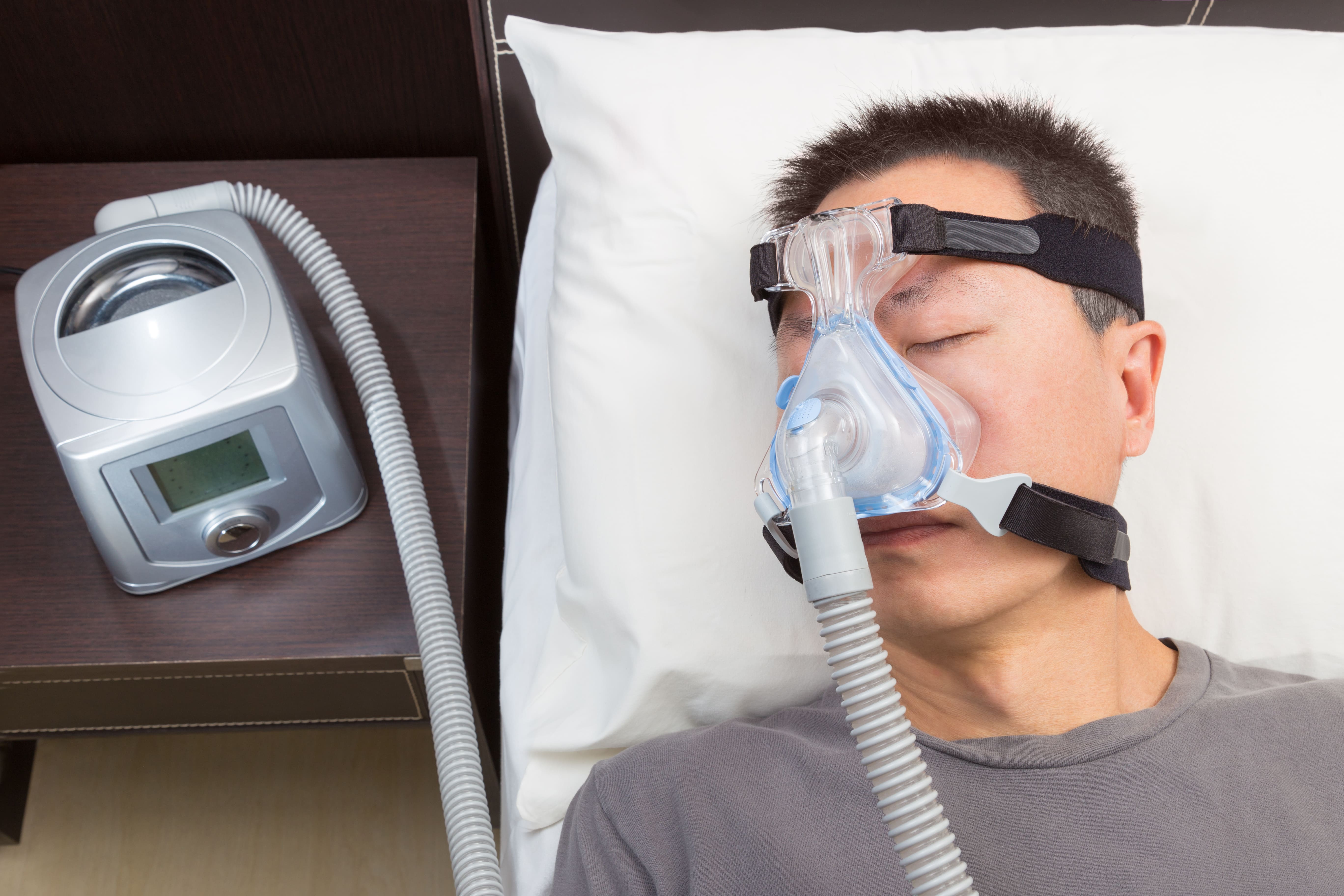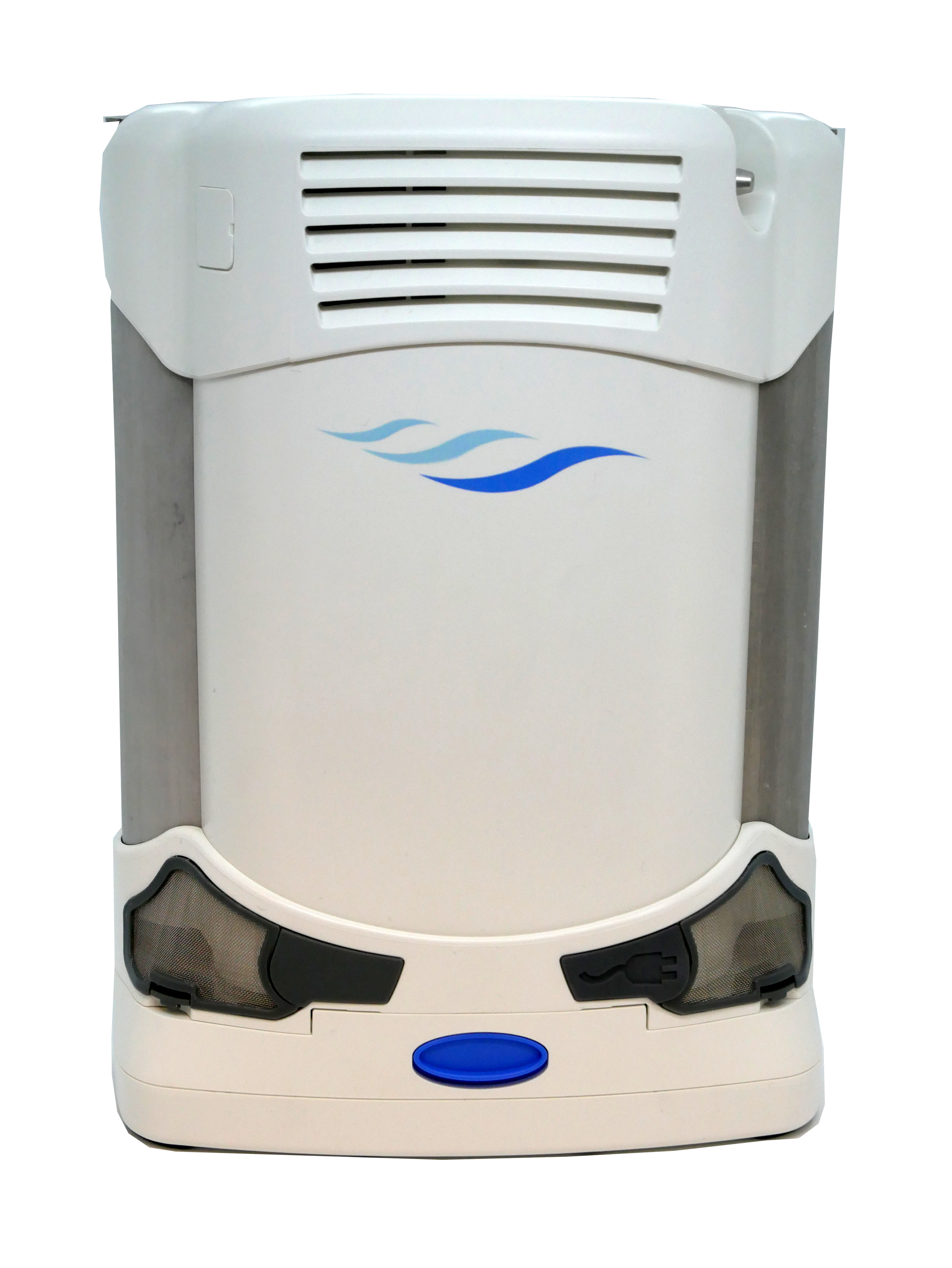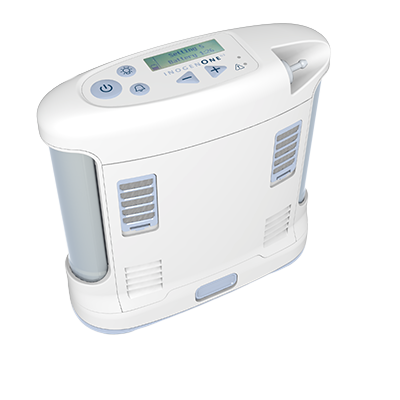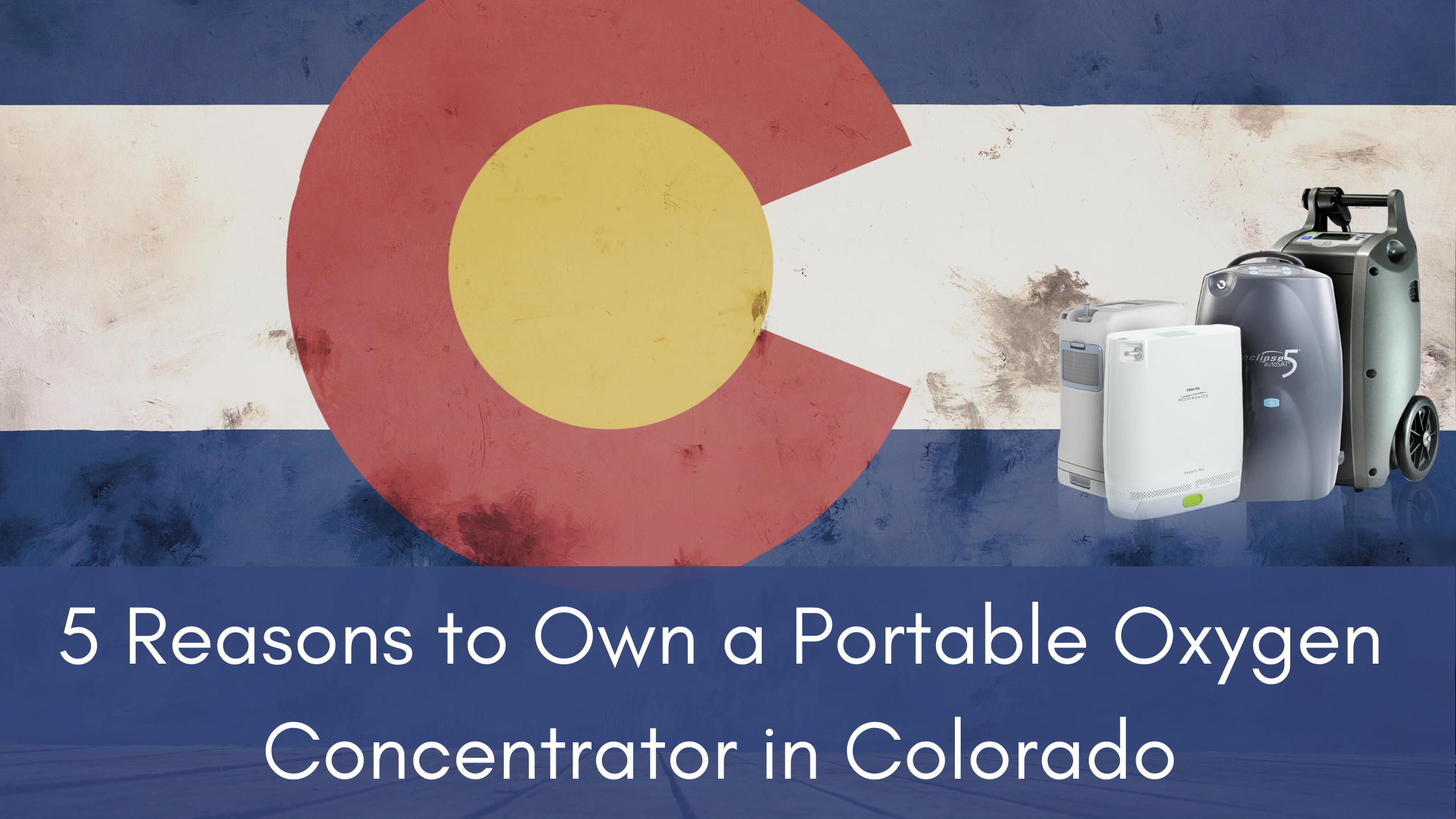
If you have a respiratory impairment like chronic obstructive pulmonary disease (COPD) or pulmonary fibrosis, you’re probably used to carefully planning your day-to-day life. From following your treatment plan to scheduling doctor’s appointments, you need to have an acute understanding of your medical needs and how to address them.
One of the medical needs you may struggle with is supplemental oxygen therapy. Depending on how severe your respiratory illness is, your pulmonologist will ask you to use medical oxygen anywhere from several hours a day to 24 hours a day. Either way, this could mean making sacrifices like staying home from activities to ensure your oxygen needs are met.
Fortunately, there is an alternative to standard oxygen therapy methods like oxygen gas cylinders and liquid oxygen devices. Portable oxygen concentrators were invented in the early 2000s and they offer the same medical-grade oxygen as traditional delivery methods, but they offer it in a much more convenient way that allows you to live life freely and on your own terms.
What’s more, if you live in a state like Colorado, the last thing you want is to be stuck at home when there are so many better things you can be doing. In this post, we’re going to take a look at 7 reasons you should be using a portable oxygen concentrator rather than other medical oxygen devices in Colorado. Remember to always consult your pulmonologist before making any changes to your respiratory treatment plan.
They Work Great at Higher Elevations
Whether you’ve lived in Colorado your whole life or you’re an out-of-stater looking to come here for work or retirement, you likely already know the state’s most defining feature: The Rocky Mountains. People come from all around the country to ski, mountain bike, and simply enjoy the fresh mountain air.
Unfortunately, as an oxygen patient, you know there’s one slight problem with this: the air is much thinner at higher altitudes. What this means is that the higher you go in altitude, the less air pressure there is, and in turn, the less oxygen you have to breathe. This doesn’t just apply to the mountains though; even Denver, the Capital of Colorado is a mile above sea level.
If you have lived at sea level most of your life and don’t travel to higher altitudes very often, you might experience something called acute mountain sickness (AMS). This typically happens when you moved to a higher elevation without giving your body enough time to acclimate to the lower oxygen levels. Anyone can experience acute mountain sickness, but it’s more common and oftentimes more severe in people with COPD or other respiratory illnesses.
Some of the symptoms of AMS include:
- Fatigue
- Dizziness
- Breathlessness
- Nausea
- Headache or lightheadedness
If someone experiencing AMS stays at a high altitude or they continue to climb in altitude, they may experience more severe symptoms including confusion, chest pain, and reduced consciousness. Another condition that can result from AMS is something called high-altitude cerebral edema (HACE). This is a neurological syndrome that causes the brain to swell with fluid and can even result in death if it’s left untreated.

Generally speaking, it’s easier for COPD patients to live at lower altitudes where it’s easier to breathe, but if you want to live at a higher altitude, you should consult your doctor in order to learn how to do it safely. He/she will likely recommend that you start supplemental oxygen therapy or alter your current oxygen therapy plan to adjust for the change of altitude. For example, if you want to travel into the mountains, you may need to use oxygen intermittently in order to maintain your blood oxygen levels while at higher altitudes.
While this is not a commonly known fact, portable oxygen concentrators work great at high altitudes. The Inogen One G5, for example, works at altitudes up to 10,000 feet above sea level meaning you’ll have no problems living in Denver and traveling to the mountains. Be aware, however, that there are several towns in Colorado that are higher than 10,000 feet like Leadville and Alma, so you should only travel to these towns if your doctor specifically advises you to.
.png)
Most portable oxygen concentrators manufactured within the last decade or so offer similar results as the G5 in terms of operating altitude. However, you should be sure to speak with an oxygen concentrator expert before making any decisions.
They’re Great for Road Trips
Taking a road trip is about as American as baseball and apple pie. While not everyone enjoys driving for hours on end or putting thousands of miles on their car, it’s hard to deny its benefits when it comes to seeing more of the country. Colorado is packed with landmarks, but you’re going to need to take a lot of road trips in order to see everything the state has to offer.

Unfortunately, traditional oxygen therapy devices like compressed oxygen cylinders and liquid oxygen tanks make road tripping an impossible feat for most oxygen patients. Oxygen tanks only provide several hours of freedom before they need to be refilled or replaced and this simply isn’t feasible for a long road trip. It’s never easy to find a place to refill oxygen tanks while you’re on the road and bringing a bunch of extra oxygen tanks is cumbersome and takes up a lot of room in the car.
Portable oxygen concentrators, on the other hand, were specifically designed with travelers in mind. These oxygen machines run off of electricity and can be charged from any wall outlet or cigarette outlet in a car via a DC charging cable. So, instead of struggling to find a place to refill your oxygen tank or carrying a bunch of backup units, you’ll have access to an infinite supply of oxygen just by plugging your POC into your car. One thing to note, however, is that most POCs will not run on their maximum flow setting while plugged into the car and you should not charge your POC while the car is off in order to prevent the battery from dying. Refer to your user manual for more information on this.
Another reason portable oxygen concentrators are so much better for road trips is that they’re far safer than traditional oxygen devices. In order to drive with an oxygen tank, you need to take a number of safety precautions because they can explode in certain circumstances. They’re also very bulky and heavy so if they end up getting jostled around in the car, they could injure someone. POCs don’t have these problems because they’re lighter, easier to handle, and don’t have any compressed oxygen.
Hiking is a Breeze
In Colorado, hiking is a popular pastime for people of all ages, and for good reason! Just a short hike every day or two can reduce stress levels, reduce the risk of heart disease, lower blood pressure, and most importantly, allow you to explore a new area that you’ve never been to before. But without an oxygen device that’s manageable, you won’t be able to hike, even if you are physically able.

‘Hiking’ implies that you will be away from pathed paths meaning it won’t be easy to wheel your oxygen device around with a rolling cart. Rocks and other obstacles will make this a lot more trouble than it’s worth and you’ll likely need to take your eyes off where you’re going which can be dangerous. On top of all this, your oxygen tubing will need to run all the way down to the oxygen tank which can be a tripping hazard as well.
While continuous flow portable oxygen concentrators like the Respironics SimplyGo are too heavy to carry on your back or shoulder, pulse dose portable oxygen concentrators like the Caire FreeStyle Comfort are not. Weighing in at just 5 pounds, you’ll be able to hike all day without experiencing back or shoulder pain and with the ergonomic curve of the FreeStyle Comfort, it won’t slide around causing you to lose balance as you walk.
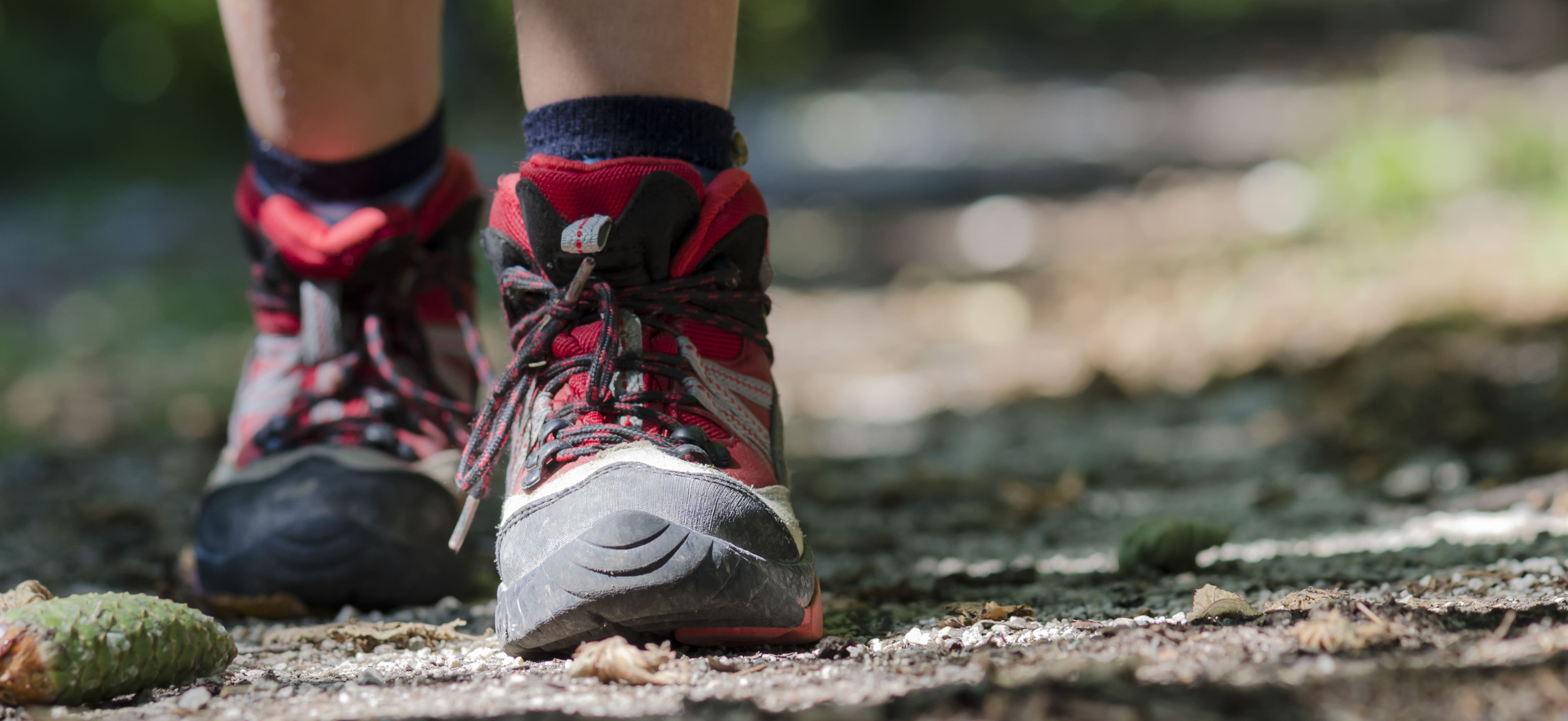
Many pulse dose machines like the Inogen One G3 offer plenty of options in the way of accessories in order to make it more comfortable and easy to carry. For example, there is the G3 backpack which has a compartment to hold the G3 and keep it secure and plenty of other pockets to hold personal belongings like keys, your wallet, or a camera. A similar carrying backpack was also available for the Inogen One G5.
If you’d like to learn more about hiking with a respiratory condition, please refer to one of our latest posts titled “You are Never Too Old for A Walk in the Woods.”
They Could Save You Hundreds of Dollars
There’s no denying that Colorado is a great place to live, especially for seniors and others looking to settle down after retirement. However, that doesn’t mean that it’s the cheapest state to live in. In the grand scheme of things, Colorado is actually pretty average when it comes to the total cost of living, but as we age and stop working, we have to get a little creative with how we spend and save our money.

As an oxygen patient, it may seem counter intuitive to look for ways to save money on your oxygen device. After all, you depend on it every day in order to feel better and improve your life expectancy. However, there are ways to reduce the amount of money you’re spending without increasing your risk of experiencing complications like COPD exacerbations.
While portable oxygen concentrators have a higher upfront cost, they’re actually much more affordable in the long run. For example, the Inogen One G4 retails at $2,295. Given that this machine is set to last 5 to 7 years on average, that’s around $0.90 to $1.20 per day of oxygen use. Compare this to oxygen tanks which cost an average of $5 or more a day to refill and maintain.
Another thing to consider is that most portable oxygen concentrators come with 3-year warranties. This will cover you with a full replacement unit in the event that you received one that is defective. And if you want an extra layer of protection, you can typically upgrade to a 5-year or lifetime warranty for an added cost. This will vary based on the unit that you’re purchasing so be sure to consult with an oxygen concentrator specialist.
Improved Self-Image
COPD and anxiety are two closely linked conditions. Physical symptoms such as chest pain and tightness can lead to natural increases in stress within the body, and people who are naturally predisposed to stress may experience even higher degrees of anxiety. Another thing that can lead to anxiety and even depression in COPD patients is their mindset. For example, someone who has a negative view of their disease and its outcome.
Believe it or not, the oxygen device that you use can also impact how much anxiety you experience. Someone who uses an oxygen tank may feel less capable and thus, experience lower self-esteem. On the other hand, someone who uses a portable oxygen machine may feel more confident because they’re thinking less about their oxygen delivery device and concentrating more on what they’re doing. POC users also report feeling more youthful and active than their oxygen tank counterparts.
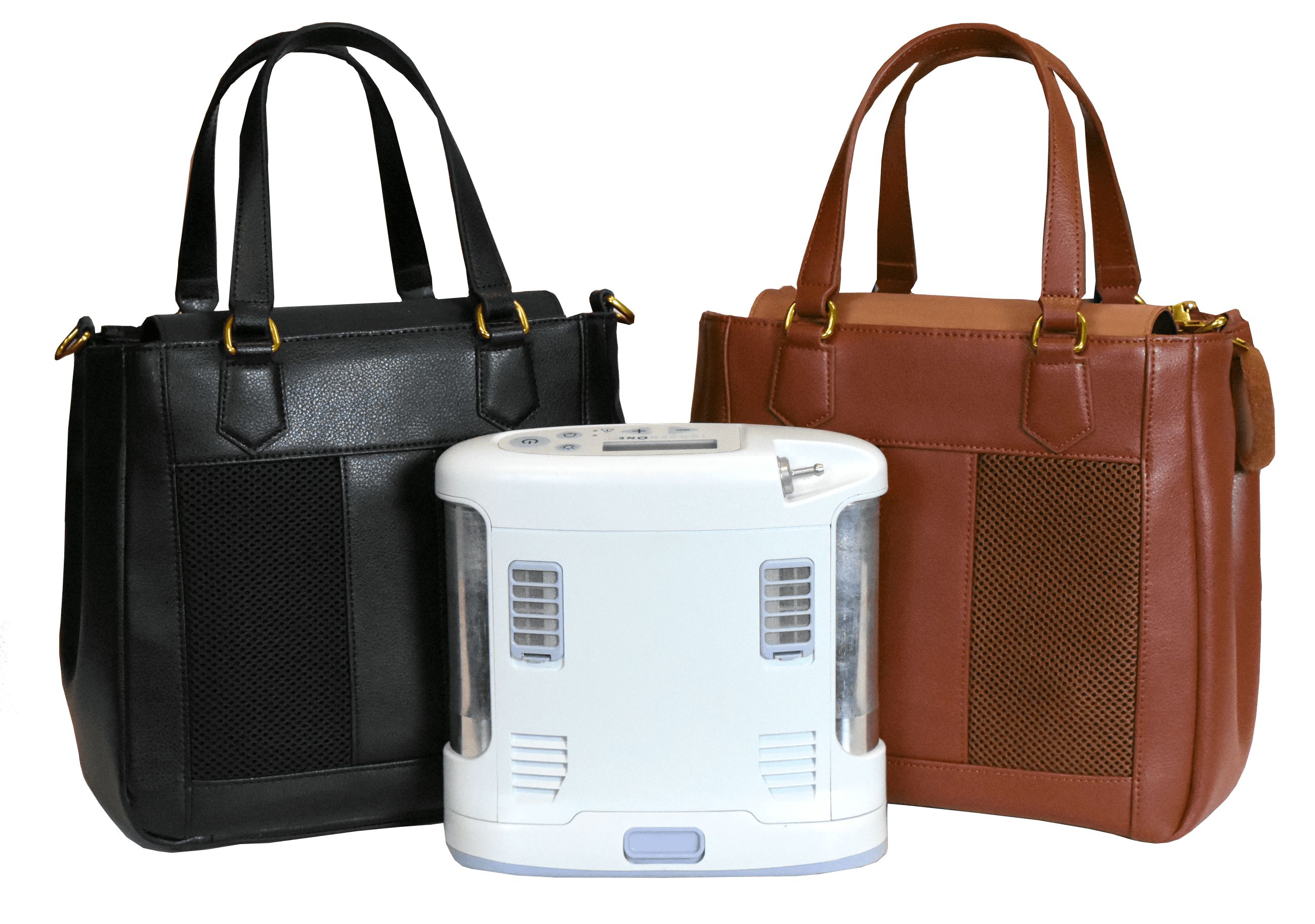
If you own an Inogen One G3 we highly recommend accessories like the GO2 Carryalls. This is a stylish carrying bag specifically designed to hold your G3 and other personal belongings. The greatest thing about this bag is that it looks like any ordinary purse or handbag so you don’t have to be self-conscious about carrying around a supplemental oxygen device. It has a sleek leather look and comes in either brown or black so it can match with just about any outfit. It also has a conveniently located zipper so that you have easy access to your oxygen cannula and the G3’s user interface.
Conclusion
Colorado has a reputation as one of the most “outdoorsy” and “active” states in the country. If you have COPD or another chronic respiratory illness, that doesn’t mean you need to give these things up; it just means you need an oxygen device that can match your lifestyle.
Portable oxygen concentrators offer significantly more freedom and independence than other oxygen devices because they’re lighter, smaller, cheaper, and they allow you to stay out of the house for longer without having to search for a place to refill.
{{cta('fa8abc2a-1e88-4fa3-82fd-1cb5b9ed43b2','justifycenter')}}
Pulse dose portable oxygen concentrators like the Inogen One G5 or Caire FreeStyle Comfort tend to be the best option for most people because they’re more reliable than their continuous flow counterparts. If you’re ready to learn more about our portable oxygen concentrators for sale, don’t hesitate to fill out the form at the side of the page or give our respiratory specialists a call.
In the meantime, check out the infographic below to see how pulse dose portable oxygen concentrators stack up against portable oxygen cylinders.
%20(1).png)
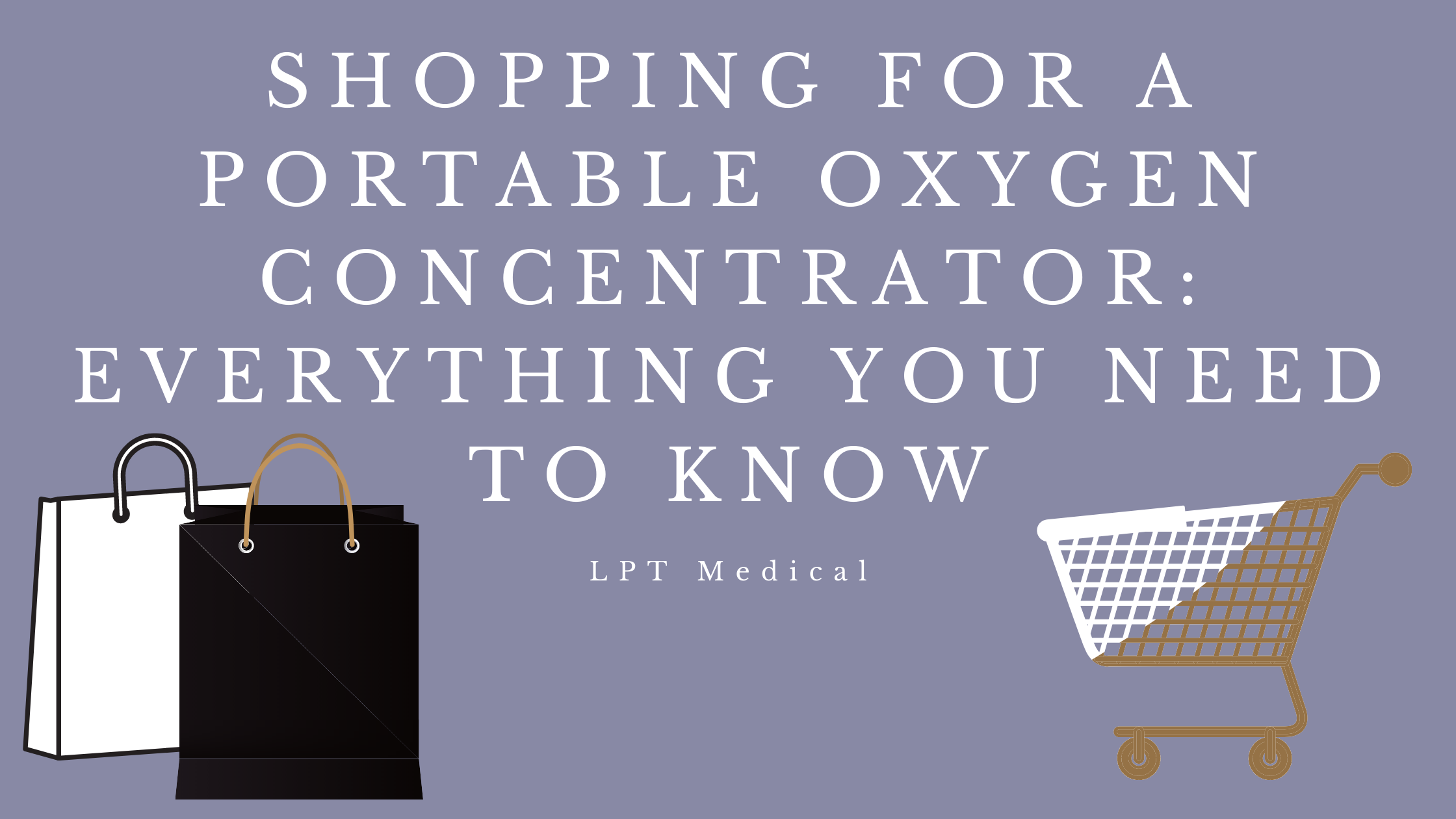
If you are new to the world of oxygen equipment this article is a great place to start. If you are an experienced oxygen user but have been thinking about changing your oxygen device, this is also a great article for you!
Oxygen therapy has been used to treat respiratory illnesses such as pneumonia as early as 1885. Fast forward to 1970, industrial gas suppliers were delivering oxygen tanks and cylinders to oxygen users, and later in the 1970’s, home oxygen concentrators were developed. Concentrators were designed to pull air from the surrounding areas so the oxygen user did not have to re-fill their tanks, so while this was a step in the right direction, both of these methods of oxygen therapy posed an important issue: lack of mobility.

It was only in 2013 when a more portable and efficient form of oxygen therapy was developed and readily available, called portable oxygen concentrators. These devices have the mobility of oxygen canisters, but never need to be refilled similar to a home oxygen concentrator.
Many oxygen users have the option: They can choose between a traditional oxygen tanks or a modern portable oxygen concentrator (POC). If they decide to go with a POC, subsequent decisions about which brand, make, and model they want to go with must be made. Which is where LPT medical comes in.
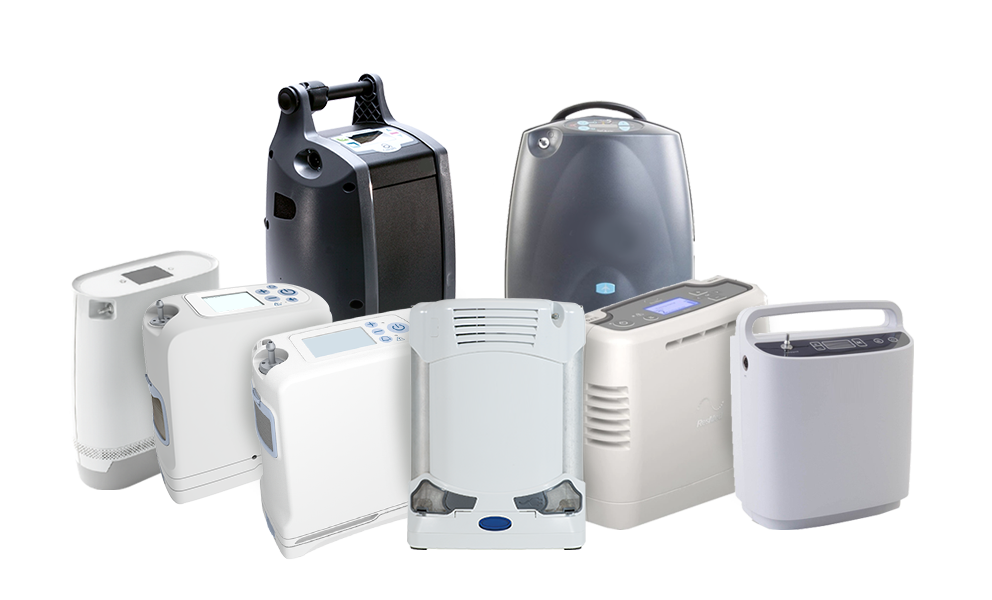
LPT Medical became one of the most reputable oxygen supply companies in Boca Raton, FL, Denver, CO, and now nationwide because we carry the most efficient and affordable oxygen equipment on the market.
{{cta('43b79c5e-6bd6-4f02-ac27-2d038d20c146','justifycenter')}}
Since 2013, there have been model after model, and new manufacturers popping up, selling portable oxygen devices, so the market has become saturated with "top of the line" equipment, making it difficult and overwhelming for the everyday oxygen patient to find the right device for their needs. Shopping for a portable oxygen concentrator is not for the faint of heart, it is a tedious task and something that takes up a lot of time and research.
This article is square one. We will tell you what factors to look for while shopping for a portable oxygen concentrator; things like battery life, weight, and flow settings are 3 of the most important factors to understand, and beyond that you should also take into consideration the sound level, if it is CPAP and biPAP compatible, if there is a warranty, and how you will afford a new or used POC.
The 3 most important factors to look out for when shopping for a POC

Battery Life
Battery life is probably one of the most important factors you should consider while shopping for a POC, after all, this is one of the main components that will influence oxygen users to ultimately decide on switching from traditional forms of oxygen therapy like an oxygen tank or canister.
Having an oxygen device that runs off of batteries and never runs out of oxygen is the ultimate freedom! Freedom from dealing with oxygen re-supply companies every week, and freedom from the fear of running out of oxygen should you leave the house with a small canister of oxygen for over a few hours.
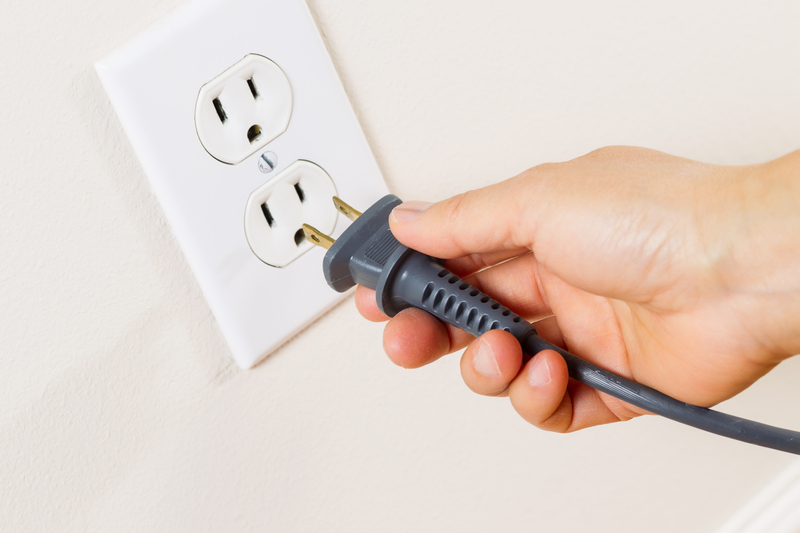
So the next step is choosing an oxygen device with battery life that will fit into your daily schedule. For instance, if you work from home, or if you spend a lot of time at home, there is no reason for you to spend extra money on a double battery when you have the option to get a device with a single battery. On the other hand, if you like to travel, have a high oxygen output prescription, or enjoy exercising, opting for a double battery device is going to be worth the extra money spent.
These are the kind of questions our respiratory specialist in Denver, Colorado and our other respiratory specialist in Boca Raton, Florida will ask you over the phone in order to help us determine which POC they should recommend for, not only your oxygen prescription but also your lifestyle.

Depending on the brand, make, and model of your portable oxygen concentrator, the batteries will drain energy differently. For example: A reliable model like the Inogen One G4 Portable Concentrator offers two different battery types, 8 cell and 16 cell also known as a single or a double battery, to meet your different oxygen supply requirements.
One thing you should keep in mind, is that the life of your POC all depends on your oxygen prescription, so how much oxygen you need per minute and therefore the setting your POC is set to. For example, if you need a high oxygen output, and your POC is set to level 4 out of 6, the battery will drain faster than if it were set to level 2 out of 6.
Pulse dose concentrators deliver oxygen only when you inhale, and so they stop when you exhale. This pause during your exhale is essentially a break for you POC, and the reduced demand for power saves energy from the battery as compared to a continuous flow mode concentrator. Continuous flow oxygen concentrators is exactly what it sounds like; they offer a constant flow of oxygen regardless of when you inhale or exhale. Because the oxygen device never gets a “break” and it is continually flowing, this type of POC will require more battery power, and they are notably heavier devices.
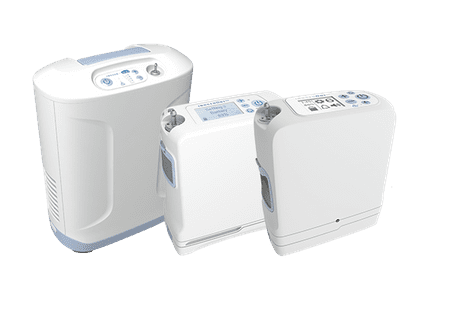
This brings us into the next section about the flow settings of you POC
Flow settings: continuous and pulse dose
Flow setting is the most obvious factor that will go into your decision while shopping for a POC. But it is also the easiest to narrow down, and not totally in your control.
Your pulmonary physician or you doctor will prescribe you a dosage of oxygen per minute and this is required to buy a portable oxygen concentrators from a licensed distributor. It is then the oxygen supply company’s job to adhere to the prescription and ensure you will be capable of fulfilling your prescription using the POC we recommend to you. Therefore the “flow settings” is not something you get to decide on, but it is something you should know and be fully aware of, because it can change.
{{cta('fa8abc2a-1e88-4fa3-82fd-1cb5b9ed43b2','justifycenter')}}
COPD is a progressive disease, meaning it gets worse over time. So, if you ever feel short of breath or notice that your COPD symptoms are worsening and you are taking you oxygen therapy as it is prescribed, you should go and see you doctor and see if you need to change your oxygen prescription.
There are POCs that allow you to switch from pulse flow settings to continuously flow settings, like the Respironics SimplyGo. The SimplyGo is the very lightest continuous flow POC on the market, and its battery can actually outlast a lot of other reputable machines out there. This is because it can operate while using one or two batteries. One battery will be perfect for things like exercising, running quick errands, and doing things around your home, while using two batteries is ideal for traveling, road trips, and extended trips away from your home!
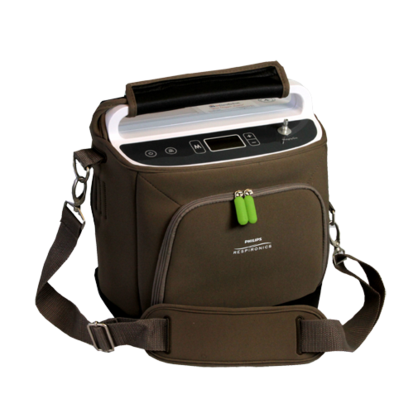
Weight
How much a device weighs is the other important factor that you should consider when purchasing a portable oxygen concentrator. Most of the time, people are looking for the most lightweight design, and in this case we suggest looking at the Caire Freestyle Comfort (5 pounds), or the Inogen One G5 (4.7 pounds), or the Respironics SimplyGo Mini Portable Oxygen Concentrator (5 pounds). And while the Inogen One G4 (2.8 pounds) is even lighter, the One G5 and Freestyle Comfort are powerful enough to accommodate mostly every oxygen patient with pulse dose oxygen needs, whereas the One G4 covers a few oxygen patients with a specific oxygen prescription.
And while there are devices that are powerful and lightweight, some people’s oxygen needs a greater than what these particular machines are capable of.
If this is you, you should not shy away from the “heavier” POCs because even though they are not extremely lightweight, they are designed to be portable and easy to maneuver, unlike the restrictive nature of even the lightest weight oxygen tank. For instance, the SeQual Eclipse 5 Portable Oxygen Concentrator is 18.4 pounds.
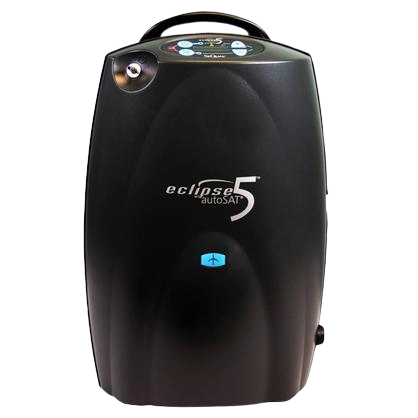
This is a continuous flow POC, and the SeQual Eclipse 5 is one of the most, if not the most, popular continuous flow portable oxygen concentrators on the market. It has a notable long-standing track record for being durable and reliable because it was designed and approved by the U.S. Military.
So even though the Eclipse is heavier than the pulse flow concentrators, standing 19.3” H x 12.3” W x 7.1” L, the SeQual Eclipse 5 is still easy to travel with, easily fitting underneath the seat in front of you! It comes with a wheeled travel cart that makes pulling your concentrator behind you seem effortless.
The travel cart is equipped with oversized wheels, an elevated platform, and a telescopic handle. The oversized wheels and elevated platform make going up curbs and stairs a breeze. They also help protect your concentrator from water when you have to go over puddles or if you live in Denver, Colorado and you have to worry about walking through snow in October through May.
The Respironics SimplyGo is the lightest continuous flow POC on the market, and it only weighs 10 pounds. This device comes with a carrying cart, or a strap to carry it over your shoulder, but 10 pounds tend to be too heavy to carry in that way. Most folks would opt for the cart to pull behind them.
Other factors
Sound level
The noise you POC makes is a personal preference, and something you should consider if noise tends to bother you. Newer models and pulse flow devices tend to be quieter because of the more modern technology available and the pulse flow machines do not need to be as powerful as a continuous flow device.

Some devices make noises similar to a fan or running water, it is a constant noise that some people would consider “white noise” and can even be relaxing, and can notably reduce anxiety. There are times where customers reach out to us and let us know that their device is making an obvious clicking noise from time to time. Most people will reach out because they are worried their POC is broken, but it is actually perfectly normal. And because the clicking noise is not constant most people do not pay any mind to this once they know it is not an issue with their POC.
Some devices are quieter than others, so if noise is a component of your priorities that you want to take into account when shopping for a POC, be sure to let your respiratory specialist know this when you speak with them over the phone at 1-(800)-946-1201. They will have a list of recommendations that they will be able to narrow down knowing how much you value silence or vise versa.
CPAP and BiPAP compatibility
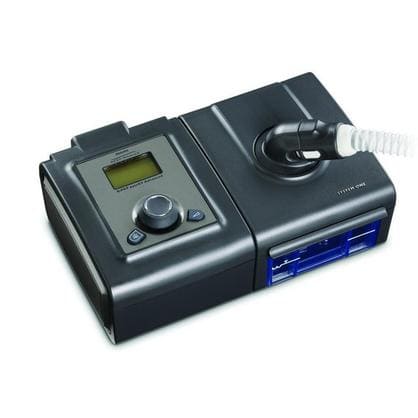
Every device that we sell is CPAP and BiPAP compatible. However whether or not you should use your POC at night should be discussed in depth with your doctor and it will be a part of your oxygen prescription. So depending on the hours per day you need oxygen, and the flow setting at which it needs to be administered throughout the day and night, will greatly influence which device we end up selling you.
If you have sleep apnea and you need a CPAP or BiPAP device while you sleep, you may also need oxygen as well. This is important for us to know beforehand, because if you are intending on using your POC while you sleep, then we must be sure that it has the capabilities of administering the oxygen you need while you sleep and not just the oxygen you need during the day.
Sleeping with oxygen can be challenging to get used, both at night and even resting throughout the day. We wrote a blog post recently about the challenges of sleeping while using oxygen and how you can overcome them and get back to a regular sleep schedule.
Click here to read The Complete Guide to Sleeping With Supplemental Oxygen
Warranty
If you are buying something new, it is always smart to go with the company that will give you a warranty. Warranty will cover expenses associated with the device should anything malfunction. At LPT Medical, we cover every new device that we sell for 3 years, and we even warranty our used machines on a case by case basis.
Affording a new or used POC
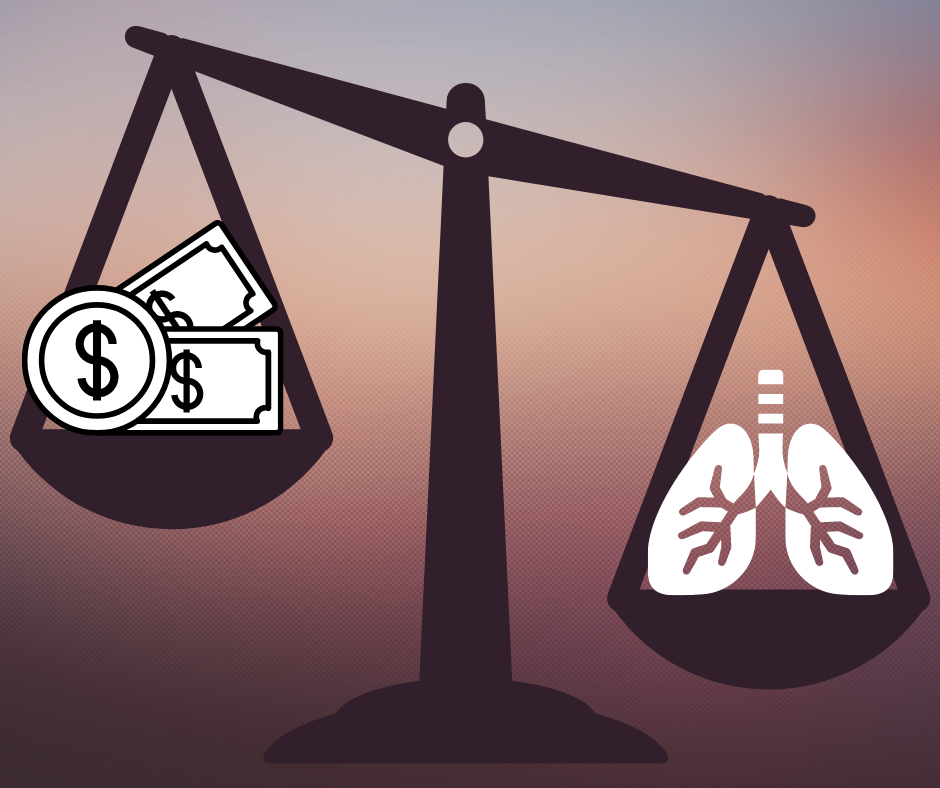
Many people will shy away from shopping for portable oxygen concentrators because they will see on google that the prices can range from $1,000 to $3,000, so without contacting anyone about these prices, they dismiss the idea of ever owning their own POC. The simple truth is that our devices never cost as much as they are being advertised online, but we are obligated to post certain prices online that align with our manufacturer’s policies. In order to speak with a respiratory specialist about the real prices for the POC you're interested in, just call us at 1-(800)-946-1201.
So not only are you not able to see the promotional deals online, but we offer a lot of alternatives would allow you to have your own POC without breaking the bank. We are able to offer you a payment plan in order t pay for your POC, we will set this up together so you do not have to pay a large sum up front. You also have the option to buy a used and refurbished unit that will be a lot less expensive than a brand new unit.
Still on the fence?
It is understandable to be unsure about whether a POC is the best option for you. The bottom line is that even if you like to stay at home most of the day or be active as much as possible, modern oxygen therapy technology will offer benefits in many facets of your life, and this is something you should seriously consider.
Technology is constantly updating with expectations to make people’s lives easier. So if you have a serious pulmonary disease, having the most modern oxygen therapy equipment is the one of the best ways to treat your disease, and the easier you can do that, the better.
The most important aspect of oxygen therapy you do not want to have to worry about, is running low on oxygen. With a POC you will never have to worry about that, because the device extracts the surrounding air and compresses it into medical grade oxygen.
POCs nowadays are designed to be portable, no matter your flow setting. Even if you need a larger device in order to provide the oxygen you need, they are easy to maneuver. Every year, our manufactures are working on new designs, with the intentions of making the most portable lightweight oxygen device that is powerful enough to meet any oxygen users' needs. Which is one of the reasons we offer a buyback program. You are able to sell your device back to us if you become interested in a different unit in the future.
We work with every customer on a case by case basis, so if you are unsure about whether or not you want to buy a portable oxygen concentrator the best way to make the decision is to reach out to us so we can help determine if a POC is right for you and your lifestyle, and how we can work with you to afford it.
Please leave a comment or email us at info@LPTmedical.com and we will gladly connect you with someone to answer any and all of your questions.
.png)
Creating an effective financial plan is essential no matter who you are or what stage of life you’re in. According to brightplan.com, having organized financials can help you improve your confidence, peace of mind, and reach both long-term and short-term goals. However, if your life becomes complicated by a chronic condition like COPD, you might find that financial planning is a lot more time-consuming and less straightforward.
Not only does COPD come with a lot of added costs like doctor’s visits, medications, and oxygen devices, but it also leads to added stress, anxiety, and worry; all of which can make it feel overwhelming to create a financial plan. Luckily, the more you educate yourself about your disease and the common financial mistakes that COPD patients make, you’ll be well on your way towards creating a more secure long-term plan.
Here at LPT Medical, we take pride in offering cost-effective long-term solutions for your supplemental oxygen needs. We offer a wide selection of portable pulse dose and continuous flow oxygen concentrators, stationary oxygen concentrators, as well as oxygen accessories that help you get the most out of your purchase. Read on to learn about some actionable tips for saving money as a COPD patient and be sure to reach out to us if you’re interested in an oxygen machine.
{{cta('fa8abc2a-1e88-4fa3-82fd-1cb5b9ed43b2','justifycenter')}}
Reduce Living Expenses
If you think about it, a lot of your money goes into essential things like your monthly rent, food, gas money, car repairs, and insurance. But just because these things are necessary does not mean that you can’t save money on them. In fact, according to a CNBC article from last year, on average, people spend $143 more than their budgeted weekly allowance. And while this may not sound like a whole lot, that adds up very quickly accounting for over $7,000 each year.
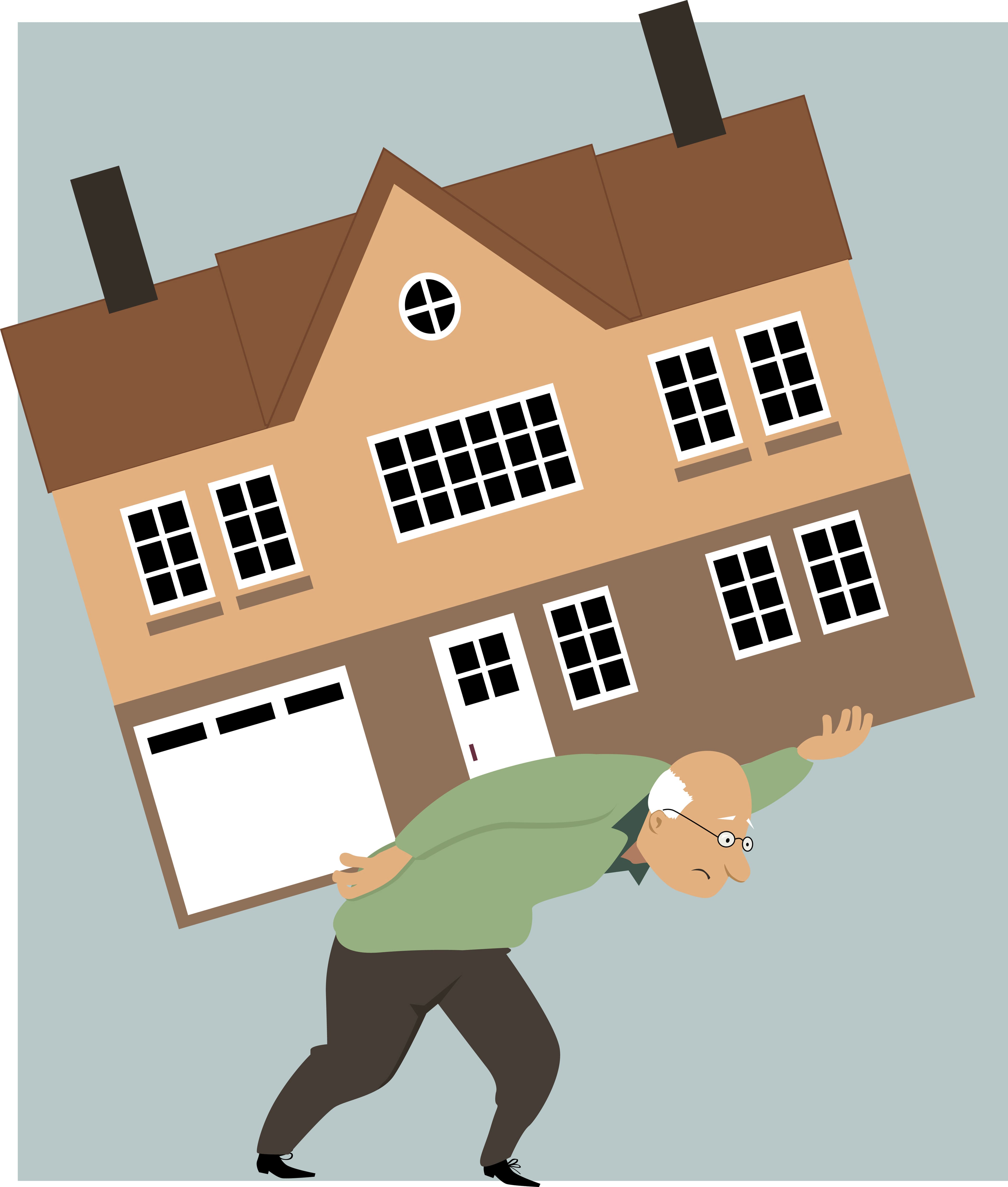
Another thing associated with living expenses is that many people assume they only affect younger people. People that are just out of high school or college are oftentimes more aware of their monthly living expenses because they don’t have that much money saved up. As a result, they need to be more frugal in the way that they use things such as utilities or how much they use their car. As we age, however, it’s easier to overspend on living expenses because we have more of a financial safety net.
One popular trend that’s being embraced by many seniors is something called “downsizing.” Simply put, this is the process of significantly reducing your expenses by getting rid of things that you don’t need. In some cases, downsizing could even mean moving from your current home into one that is physically smaller and less costly. By doing so, you’ll be able to save up more money each month for things like doctor’s visits and COPD medication.

Another living expense that COPD patients may struggle with is the prospect of applying to a nursing home. According to AARP, a nonprofit organization designed to support people over the age of 50, the cost of long-term care options like nursing homes is skyrocketing. Because of this, many people with disabilities are opting for cheaper options that don’t break the bank.
Reduce Unnecessary Spending
Unnecessary spending differs from living expenses in the fact that they are not essential. This includes things like subscription services, gym memberships, cigarettes, or any other type of “luxury” product or service. The problem is that nowadays it’s so easy to spend money. Online shopping has become such a common way for people of all ages to pass their time but it’s also very easy to lose track of how much you’re actually spending.

Cigarette smoking is another expense that can really add up over time. Believe it or not, around 38 percent of people with COPD still smoke despite the fact that 85 to 90 percent of COPD cases are the result of smoking. What’s more, smoking a pack a day can run you around $2,292 each year. Not to mention the fact that continuing to smoke while you have COPD will increase your risk of experiencing an exacerbation and cause your diseases to progress more quickly. Inevitably, this will lead to more medical expenses.
Another unnecessary expense that many people fall victim to is subscription services. It seems like just about every product or service nowadays is bound to a subscription payment in hopes that consumers will start one and forget they have it. Unfortunately, this is usually what happens. Take some time to go through your bank statements and identify any recurring costs, and if they aren’t absolutely necessary then you should eliminate them.

Limit Hospital Visits
By far the biggest expense for anyone with a disability like COPD is a hospital visit. You may be surprised to find that the average hospital visit costs the patient $10,000 and hospital stays are responsible for 60% of all bankruptcies. With this information in mind, it should be your number one priority to prevent medical emergencies that facilitate a need to visit the emergency room.
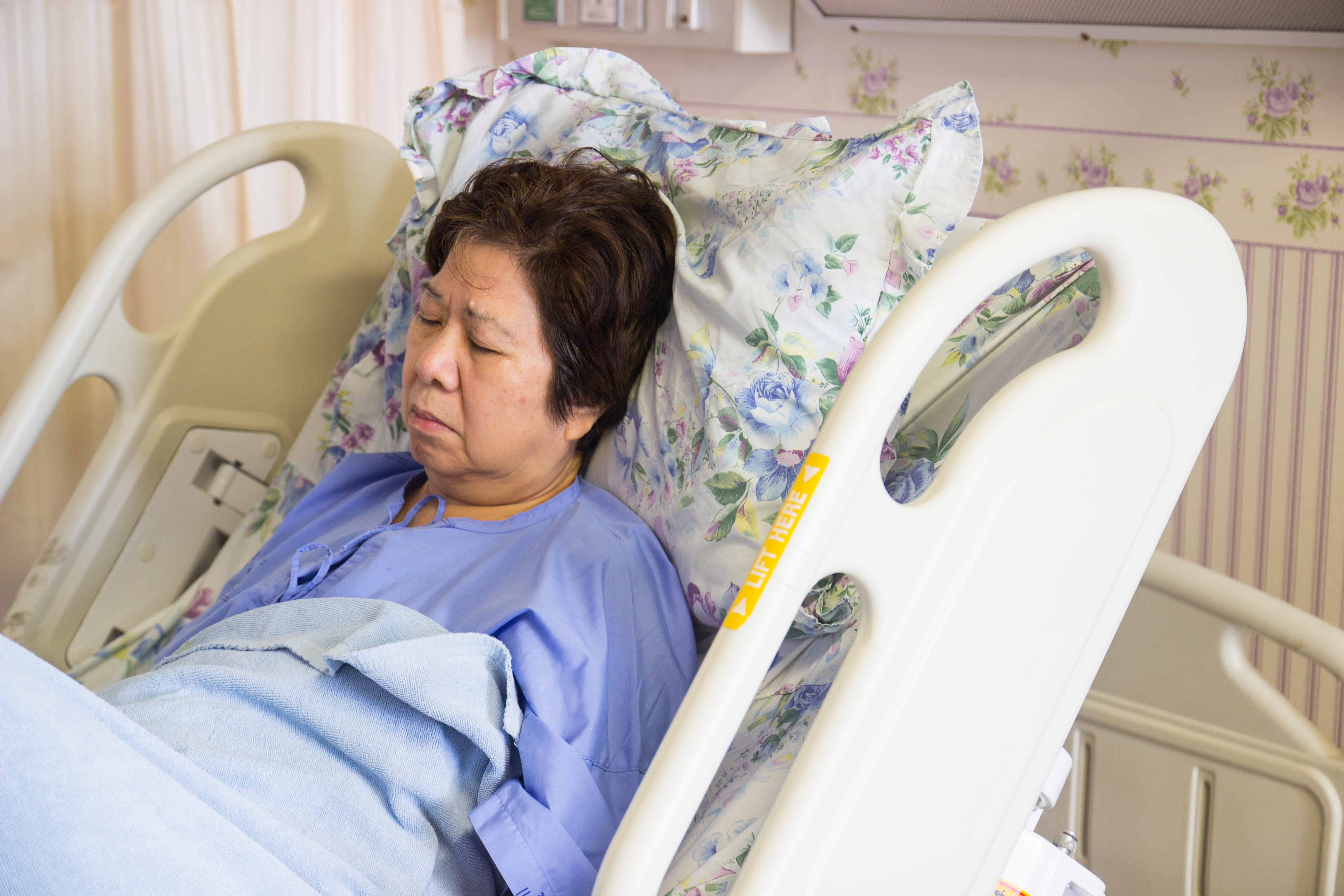
The best way to prevent medical emergencies related to COPD is to follow your COPD treatment plan and avoid exacerbation triggers such as smoke, pollution, and other airborne particles. And due to the fact that infections are the most significant cause of exacerbation, you should also take safety precautions like getting your annual flu shot and staying up-to-date about COVID-19.
The most essential components of your COPD treatment plan include supplemental oxygen therapy and pulmonary rehabilitation. Oxygen therapy will help you keep your blood oxygen levels stable wherever you go which can prevent respiratory failure and pulmonary rehabilitation will keep your lungs and muscles working efficiently making it easier to breathe.
Learn About Social Security Disability Benefits
Old-age, Survivors, and Disability Insurance (OASDI) is the official name for “social security benefits” in the US. This program is funded by the Federal Insurance Contributions Act (FICA) taxes made by employees and matched by employers. According to the official Social Security website, Social Security benefits play a crucial role in the economic well-being of millions of Americans. So, when it comes to managing your finances with COPD, it’s important to know what your social security benefits allowance is.

The social security administration defines a disability as any condition that prevents you from participating in “substantial gainful activity” for 12 months or more. In other words, if you are unable to work due to severe respiratory symptoms you should start collecting social security in order to help you pay for medical expenses. However, in order to determine whether COPD is severe enough to warrant SS benefits, they use something called the “Blue Book.” COPD is listed under section 3.02.
In order to qualify for social security benefits, you also need evidence of your COPD diagnosis. First and foremost, you’ll have to provide a full history of your COPD including symptoms, prognosis, and physical examination results. Below are some of the test results that you should provide:
- Pulse oximetry
- Hospital records
- Spirometry results
- Lung function tests
- Supplemental oxygen prescriptions
- Imaging tests such as CT scans
- Arterial blood gas tests
{{cta('43b79c5e-6bd6-4f02-ac27-2d038d20c146','justifycenter')}}
Remember that it is possible for them to deny your social security benefits claim for COPD. Because of this, it’s important to gather all the medical information you can before filling out the claim. It takes around 3 to 5 months to process your documents and let you know the results, so if you are careless in how you go about the process, you may be waiting a lot longer than expected to start receiving your benefits. Here are some tips to ensure that you’re doing the process correctly:
Fully Understand the Blue Book
The Blue Book also called the “Disability Evaluation Under Social Security” highlights medical conditions and the symptoms that need to be specified in order to receive benefits. You can either view an updated version of this book online or you can receive one in the mail which may take several weeks. This document is used as a guide book for agency officials when determining the validity of your application, so it’s important to read and understand it, especially the section that pertains to your condition.
Receive Up-to-Date Lung Function Tests
One good way to ensure that you’re receiving your full allowance is to get up-to-date tests. For example, if you received a spirometry test several years ago, you may want to consider having another test done. COPD is a progressive disease meaning it tends to get worse over time, so you want the documents you send to the SSA to reflect that.
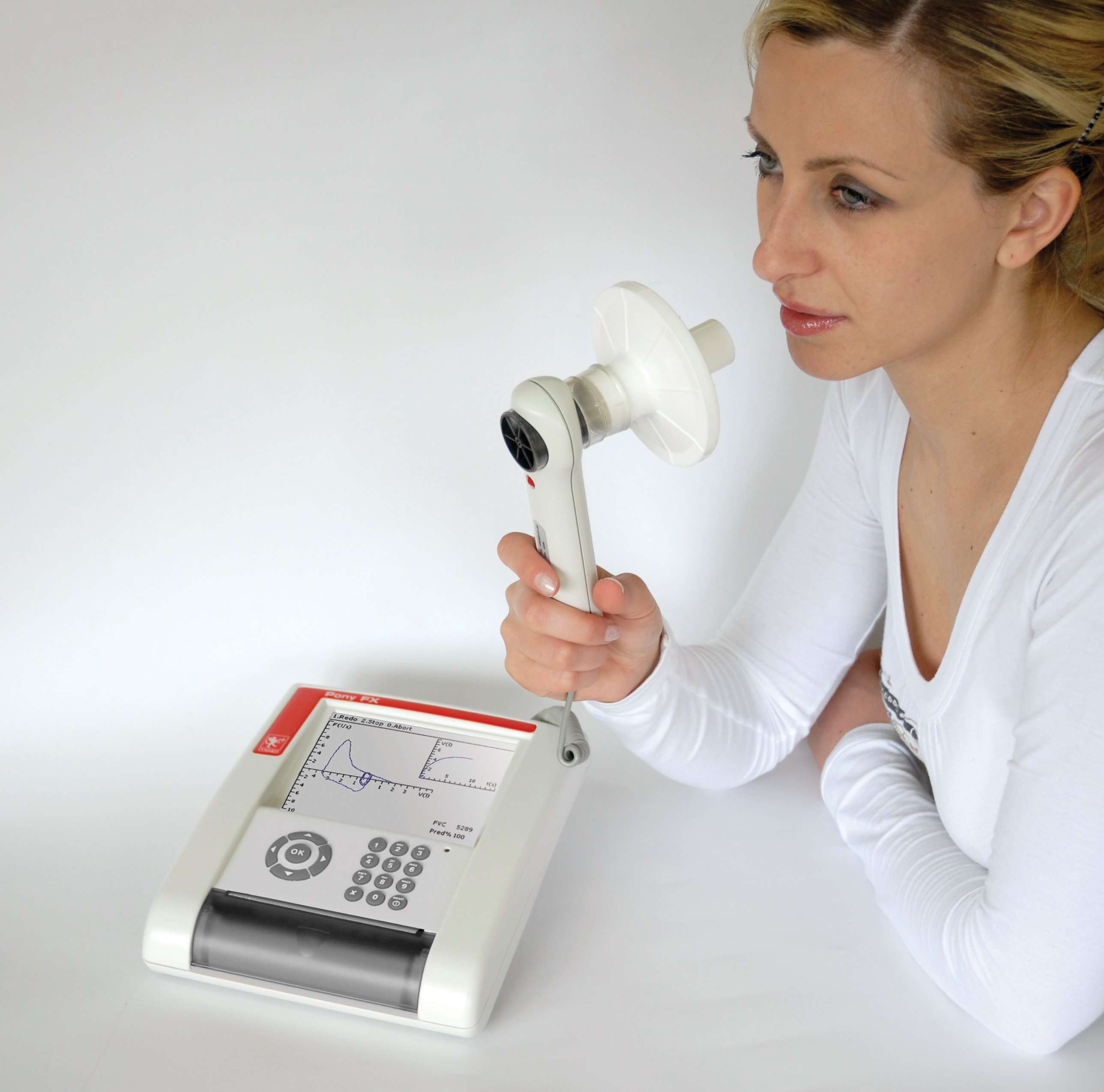
Learn About Medical Vocational Allowance
In certain situations, it is possible for someone with severe disability to not qualify for social security benefits. However, there is something called a medical vocational allowance which can make this possible. What you’ll need to do to qualify for this is to prove that your disability has prevented you from working a job that you’ve been trained to do. Since COPD significantly impairs lung function, you should have no problem proving this if you are involved in manual labor work.
Contact a Social Security Attorney or Advocate
If you’re worried about qualifying for social security benefits or you believe you have been wrongly denied for benefits, you may consider working with a social security attorney or advocate. One of the greatest benefits of contacting an SSDI attorney is that you’re protected by something called a contingency fee arrangement. What this means is that your attorney is only allowed to charge you a fee if you win the case. What’s more, the fee is capped at 25 percent of the past-due benefits awarded to you, up to a maximum of $6,000.

Cut Costs on Medication
Medication is another area that COPD patients tend to overspend in. There are a large variety of medications that you may be required to take for COPD including bronchodilators to prevent shortness of breath, antibiotics that prevent infection and exacerbations, and anti-inflammatories which reduce flare-ups. Unfortunately, many COPD patients purchase these expensive medications without taking the time to consider how they can save money. We discussed this topic in detail in a previous post, but we’ll go over it again for your convenience.
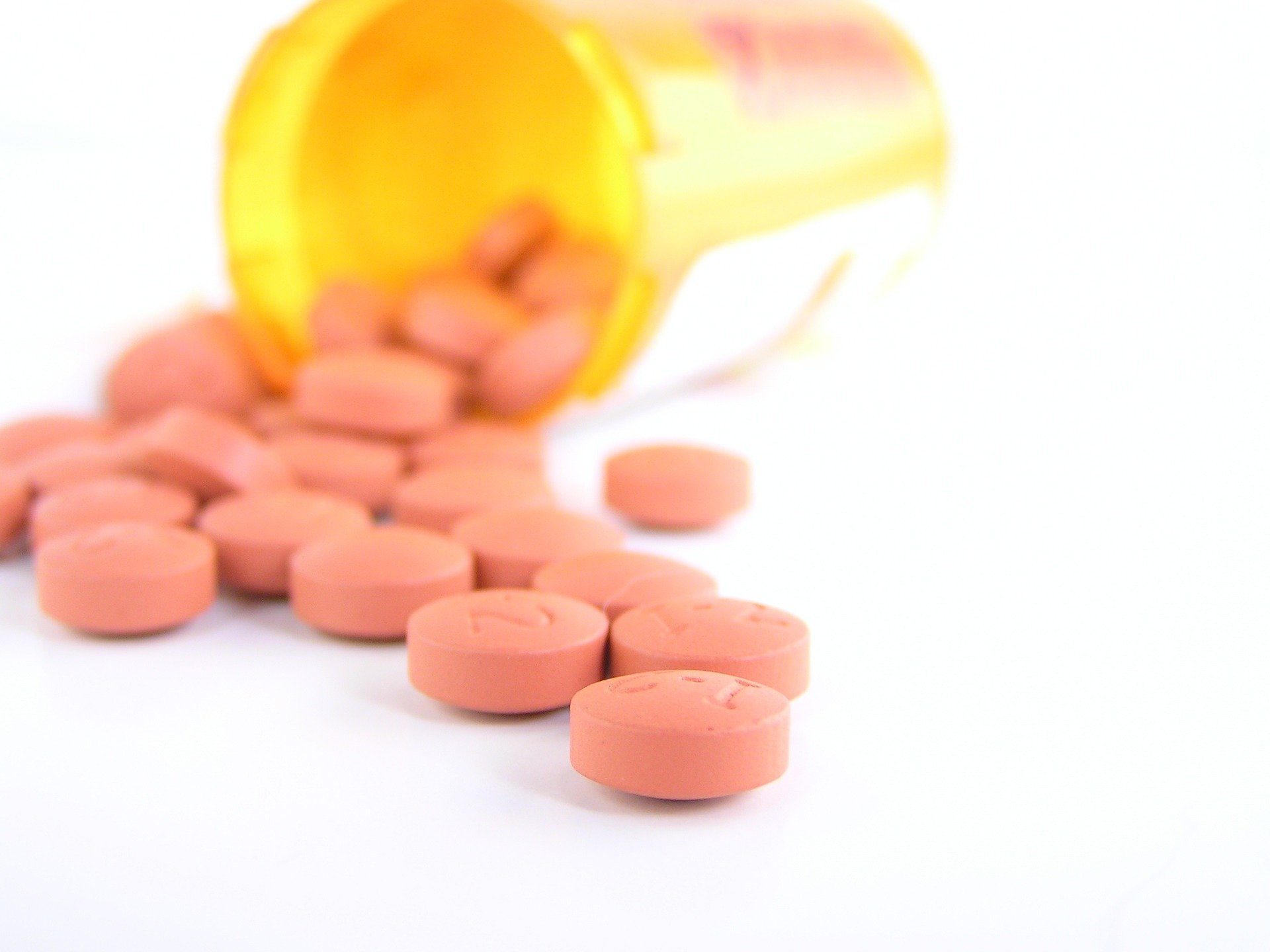
Order Prescriptions Online
Most peoples’ gut reaction after being given a prescription is to go to their local pharmacy. While there’s nothing wrong with this approach, it will likely mean spending significantly more money on your medications. Rather, it’s often a better option to research online pharmacies because there is more competition meaning they will offer lower prices. Many online pharmacies also offer free shipping and quick turnaround times, so you shouldn’t have to wait too long to receive your medication.
Purchase Generic Brands
While you’re probably constantly bombarded with advertisements of name-brand medications, these are not the only options out there. In fact, many generic brands offer the same exact product for a much lower price. If you want to save some money, ask your doctor about generic brand medications to see if they will work for you.
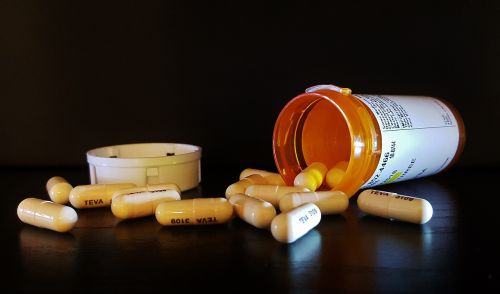
Use a Patient Assistance Program (PAP)
Believe it or not, many pharmaceutical companies offer patient assistance programs designed to help low-income people pay for their medication. Oftentimes, these programs require you to make below a certain income, you must be a US citizen, and you can’t be a part of any other patient assistance program with a different pharmacy.

Ask Your Doctor for Advice
Last but certainly not least, you should always consult your doctor before making decisions about your medication. Not only will he/she have advice for you to save money on your medications, but he/she may also warn you of common pitfalls of the pharmaceutical industry. Medication is expensive these days so it’s important to take the time to understand your options.

Participate in a Clinical Trial
A clinical trial is a program designed to test the safety and efficacy of new medications and treatments before they hit the market. Clinical trials are carefully designed by medical professionals and they must be approved by the US Food and Drug Administration (FDA). These research programs depend on volunteers, so it’s very easy for anyone to sign up for one and get involved.

The benefit of participating in clinical trials for COPD is that you may be able to test new medications for free and in some cases, researchers will even pay you to participate. What’s more, the researchers will thoroughly examine your medical history to ensure the new medication doesn’t negatively interfere with your condition. Generally speaking, clinical trials are safe and they can save you hundreds or thousands on your medical expenses. It’s also nice knowing that you have the power to help researchers test new drugs and treatment procedures. If you’re interested in researching COPD clinical trials, visit clinicaltrials.gov.
Invest in a Long-Term Oxygen Therapy Solution
Supplemental oxygen therapy is a reality for most COPD patients. Whether you have stage one COPD or stage four COPD, medical oxygen helps to ensure that your blood oxygen levels remain stable and that you can breathe easily. Unfortunately, many COPD patients take the wrong approach when it comes to purchasing a medical oxygen device and it often costs them more in the long run.
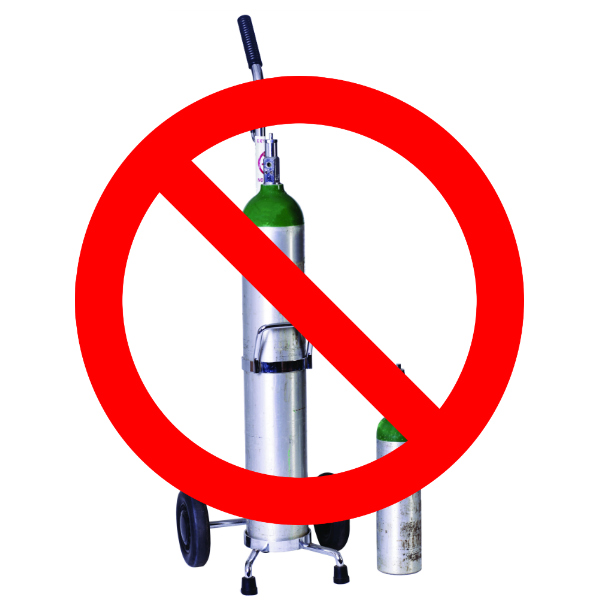
Oxygen tanks are a very popular oxygen for oxygen therapy because they are accessible and have low upfront costs. The problem, however, is that the costs add up very quickly because you have to keep refilling them. Since they run out of oxygen so quickly most people keep two or more on hand at any given time. They’re also really heavy, bulky, and dangerous to use.
Alternatively, you could invest in a long-term oxygen therapy solution like a portable oxygen concentrator. Rather than refilling oxygen concentrators as you would with an oxygen tank, these devices draw in ambient air and output medical-grade oxygen. Since these are electronic devices, all you need to do is have access to a power outlet in order to charge the batteries. Additionally, portable oxygen concentrators are extremely lightweight and easy to carry making them perfect for traveling and getting out of the house.
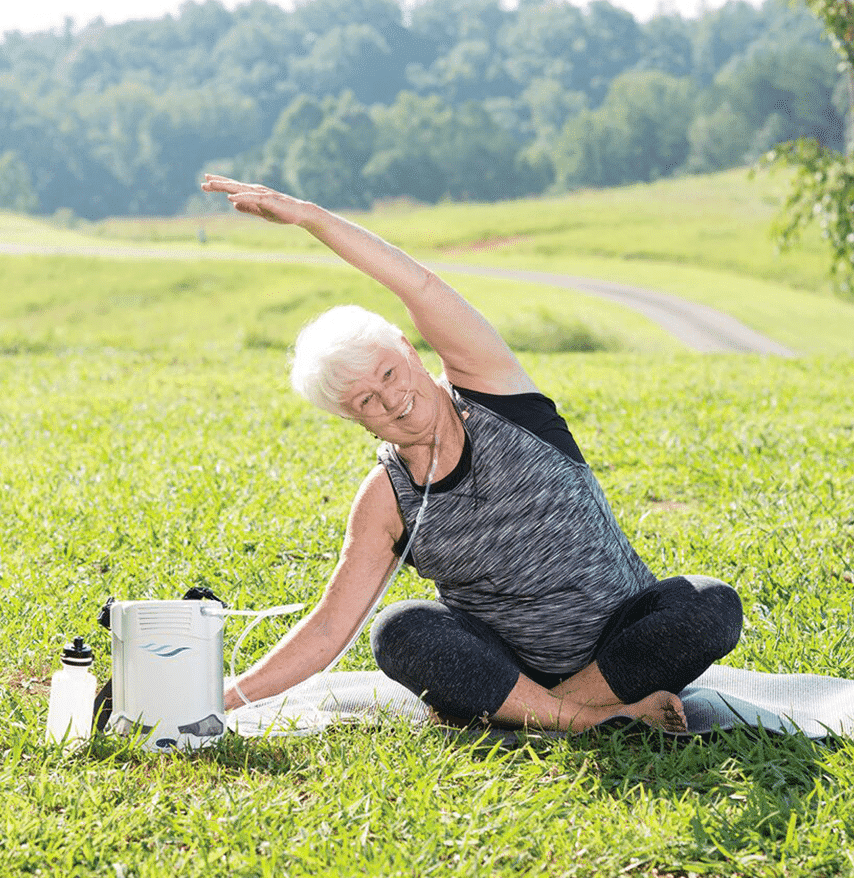
If you’re looking to save money in the long term and you want a powerful, reliable oxygen device, we recommend either the Caire FreeStyle Comfort or the Inogen One G5. Each of these units is 5 pounds or under, they offer over 10 hours of battery life, and they can last you between 5 and 7 years with minimal maintenance. They also have 3-year warranties which will protect you from rare occurrences like manufacturing defects.
.png)
The above portable oxygen concentrators are pulse dose delivery, meaning they deliver oxygen whenever the user inhales. In certain situations, your doctor may require you to use continuous flow instead. In this case, we recommend using the Respironics SimplyGo. This oxygen machine is not quite as light as the other two but it is the most reliable and trusted continuous flow portable oxygen concentrator on the market.
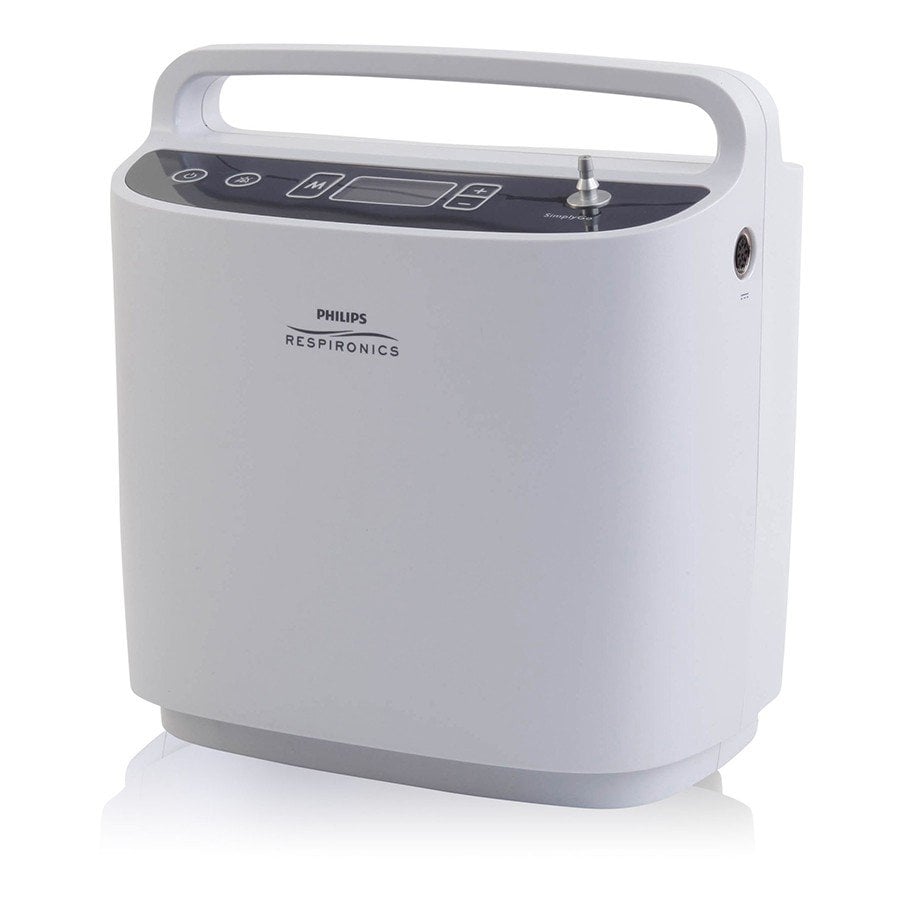
While portable oxygen concentrators have a larger upfront cost, they are always the best long-term solution. Another benefit of owning one is that if you ever decide you want to upgrade to a newer model or your doctor tells you that you no longer need oxygen, many oxygen retailers will buy back your oxygen concentrator. This is usually not possible with oxygen tanks because most oxygen companies just rent them out rather than selling them.
Speak With a Financial Advisor
Seeking out the help of a financial advisor is usually a last resort for the average person. Some financial advisors charge a pretty penny for their work and some people simply have nothing to gain from it. However, if you’re overwhelmed with financial decisions after being diagnosed with COPD and you can find the right financial expert to go to, it’s always something to consider.

A financial advisor will walk you through all of your financials and put together a long-term plan that will help you meet your goals. Oftentimes, they will tell you where to invest your money and give you a monthly allowance for what you’re allowed to spend. They’ll also help you better understand how to deal with the increasing number of medical expenses that you’re having to deal with.
Conclusion
Financial planning is something that we all have to deal with throughout our life. Taking the time to understand how much money you have and understanding where you should invest that money is crucial to living comfortably. Unfortunately, if you’re coping with a chronic lung disease like COPD, asthma, or pulmonary fibrosis, the process of planning your finances may be difficult and time-consuming.
On a positive note, if you take the time to understand your condition and some common mistakes that COPD patients make, you can avoid some major financial pitfalls. Hopefully, some of the tips listed in this article got you started on the right foot, and if they did, be sure to share it with a friend or loved one who may be struggling with the same issue.
.png)
From the novel coronavirus to devastating wildfires, 2020 has been a challenging year for us all. But for people with chronic respiratory illnesses like COPD or asthma, this year has been the ultimate test. The good news is that, by following all COVID-19 safety precautions stated by the World Health Organization (WHO) and by checking the air quality index (AQI) before leaving the house, many COPD patients have adjusted nicely to a new way of life.
With the holidays coming up, you may be wondering how you can stay safe while still catching up with friends and loved ones. Whether you’re flying across the country or you’re just going down the street, it’s important to prepare well enough in advance so that you can stay healthy and happy and avoid emergencies like COPD flare-ups and exacerbations. Conversely, if you are having relatives over to your house, you should ensure your home is safe for you and your guests.
{{cta('b59df0c1-c4de-47a8-8e1c-0d33d4b414aa','justifycenter')}}
In this post, we’ll take a look at several of the most important safety tips you should take into consideration. As always, if you have any questions for us, feel free to leave them in the comment section and we’ll do our best to answer them as soon as possible. What’s more, if you have any questions about your COPD treatment plan or you’re thinking of making changes to your diet, exercise routine, or medication, please consult your doctor beforehand.
Upgrade to a Portable Oxygen Concentrator
Chances are, you know exactly what it’s like to use an oxygen tank during the holiday season. First and foremost, you have to have a plan as to how you will refill your oxygen tank while you’re away from home. This could mean bringing a spare tank or researching oxygen companies in the area that can deliver oxygen to you. Unfortunately, it can be very difficult to find an oxygen company that’s actually open during the holiday season.
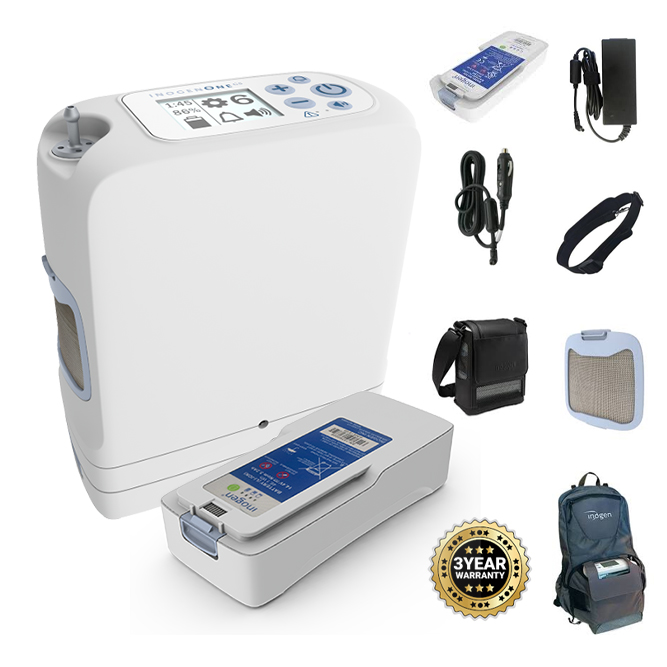
The next thing you have to consider is how you will actually transport your oxygen. Oxygen tanks are banned on all airlines, so taking a flight is out of the question. It’s also very dangerous to travel with an oxygen tank in your car, so you will have to take a number of safety precautions in order to ensure that it doesn’t move around while you’re in transit. Last but not least, you’ll have to spend your whole holiday keeping a close eye on your tank, making sure it’s not exposed to any open flames or anything that could damage the fragile components.

Fortunately, using a personal oxygen concentrator is much easier and safer. Travel size oxygen concentrators like the Caire FreeStyle Comfort are lightweight, compact, and most importantly, they’re much safer to use than a standard oxygen tank. Portable oxygen concentrators are electronic devices that draw in ambient air, remove unneeded gases, and then put out medical grade oxygen. As a result, they don’t store oxygen at high pressures like oxygen tanks do.
Another reason they’re safer is that they have an implemented “breath detection technology” which cuts off oxygen flow if no breath is detected. Since oxygen increases the flammability of everything it comes in contact with, you can rest assured you’ll be safe if you accidentally drop your nasal cannula and leave it for an extended period of time.

One final reason that portable oxygen concentrators are safer to use during the holidays is that they don’t create a tripping hazard. If you use an oxygen tank, you will have to wheel it around on a carrying cart meaning your nasal cannula will have to run from the tank to your nose. However, portable oxygen concentrators like the Inogen One G5 can be slung over your shoulder and tucked under your arm so that it’s always accounted for. What’s more, you can keep your oxygen tubing nice and short so that it’s not dragging on the ground.
Have a Plan for Dealing with Exacerbations
According to the American Thoracic Society (ATS), a COPD exacerbation is a period of worsening symptoms, most commonly caused by infection. And unfortunately, being around your family and extended family during the holidays will put you at a higher risk of contracting illnesses like the flu, the common cold, and even the coronavirus. Contrary to popular belief, most medical experts recommend wearing a mask if you have COPD. As long as you’re using supplemental oxygen therapy as prescribed and you’re checking your blood oxygen levels regularly, the mask should not affect your symptoms.
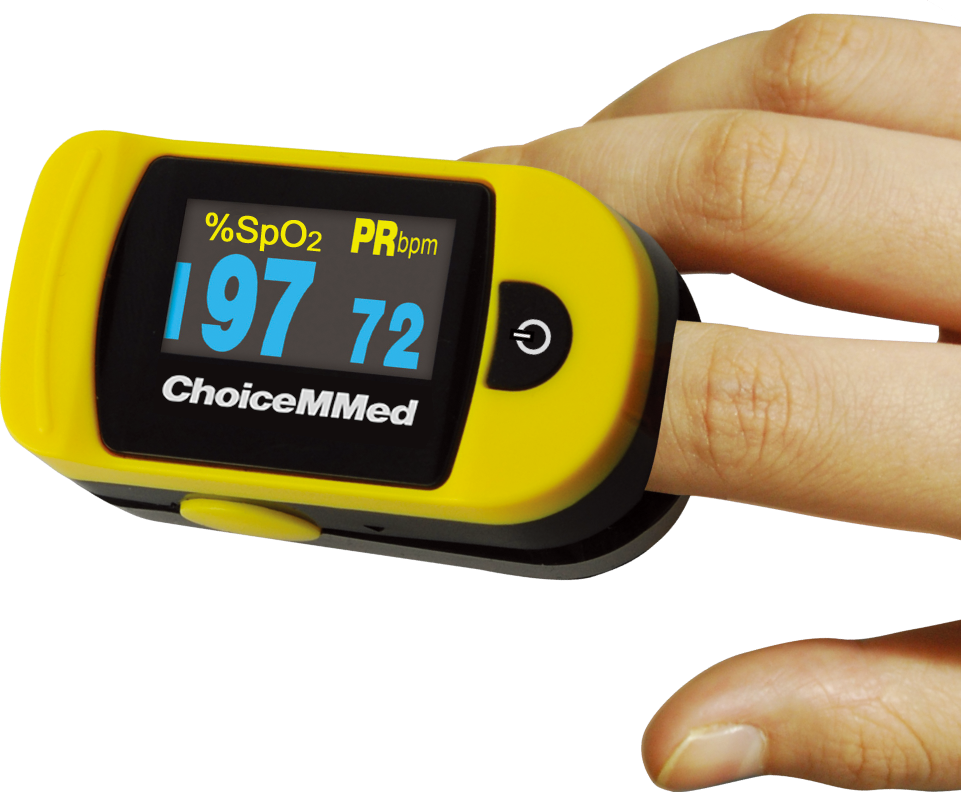
If you’re someone who experiences anxiety or claustrophobia while wearing a mask, there are a number of techniques you can try to alleviate this. Since claustrophobia is closely linked to how you breathe, taking the time to learn breathing techniques like diaphragmatic breathing can help you in the long run. This involves concentrating on using your diaphragmatic muscles to breathe rather than your chest muscles. Another thing you can try is cognitive-behavioral therapy (CBT) which can help you pinpoint the root cause of anxiety and learn ways to cope with it in a manageable way.
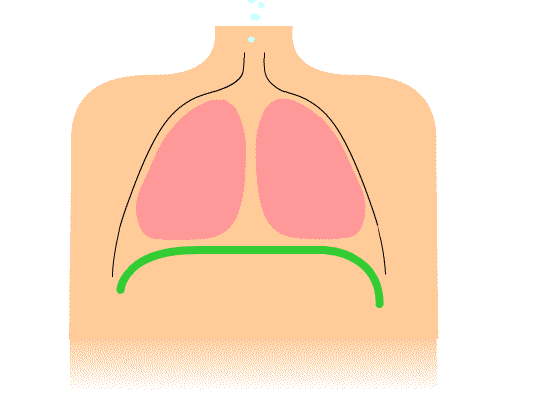
Aside from wearing a mask, you should follow all other COVID-19 safety guidelines. This means maintaining 6 feet of distance between other people, washing your hands regularly throughout the day, and making others aware that you’re a high-risk individual. Making others aware of your condition is important because if there was an emergency, they would need to know how to help. If you want, you can even write down an action plan to help you out in a difficult situation. If you’d like to learn more about COPD action plans, read through this post.
Don’t Fall Back on Old Habits
When you were diagnosed with COPD, you likely had some significant obstacles to overcome. Smoking cessation, an improved diet, and a consistent exercise routine are all necessary to get back on track and slow the progression of COPD. Unfortunately, all the bad habits you dropped when you were diagnosed with COPD can come flooding back when you’re around people you haven’t seen in a while.

Before leaving the house for the holidays, it’s important to mentally prepare. While the holiday season is all about relaxing and letting go, you don’t want to be so relaxed that you forget about your COPD treatment plan. One thing most people do on Thanksgiving and Christmas is overeating. This may be relatively harmless for someone who’s healthy, but for someone with COPD, this could mean exacerbating your lung symptoms.
{{cta('fa8abc2a-1e88-4fa3-82fd-1cb5b9ed43b2','justifycenter')}}
The main reason you don’t want to overeat during the holidays is that it can lead to bloating. When this happens, you’ll notice that you have a harder time breathing and you’ll be more likely to experience chest pain or a chronic cough. Secondly, COPD patients have a hard time processing a lot of food all at once. This is why doctors recommend eating smaller meals spread throughout the day because it is easier for your body to manage. Eating large meals can also lead to weight gain.

According to U.S. News, being overweight has a number of negative effects when it comes to managing your disease. Overweight individuals will get out of breath faster and excess body weight on the stomach and chest can interfere with breathing. Another problem is that overweight people tend to maintain a diet high in carbohydrates which get converted to carbon dioxide (CO2) during digestion. This means you’ll be struggling to get the oxygen you need to maintain your blood oxygen levels. So, if you want to eat healthy this holiday season be sure to focus on portion control and avoid foods that are high in carbs.
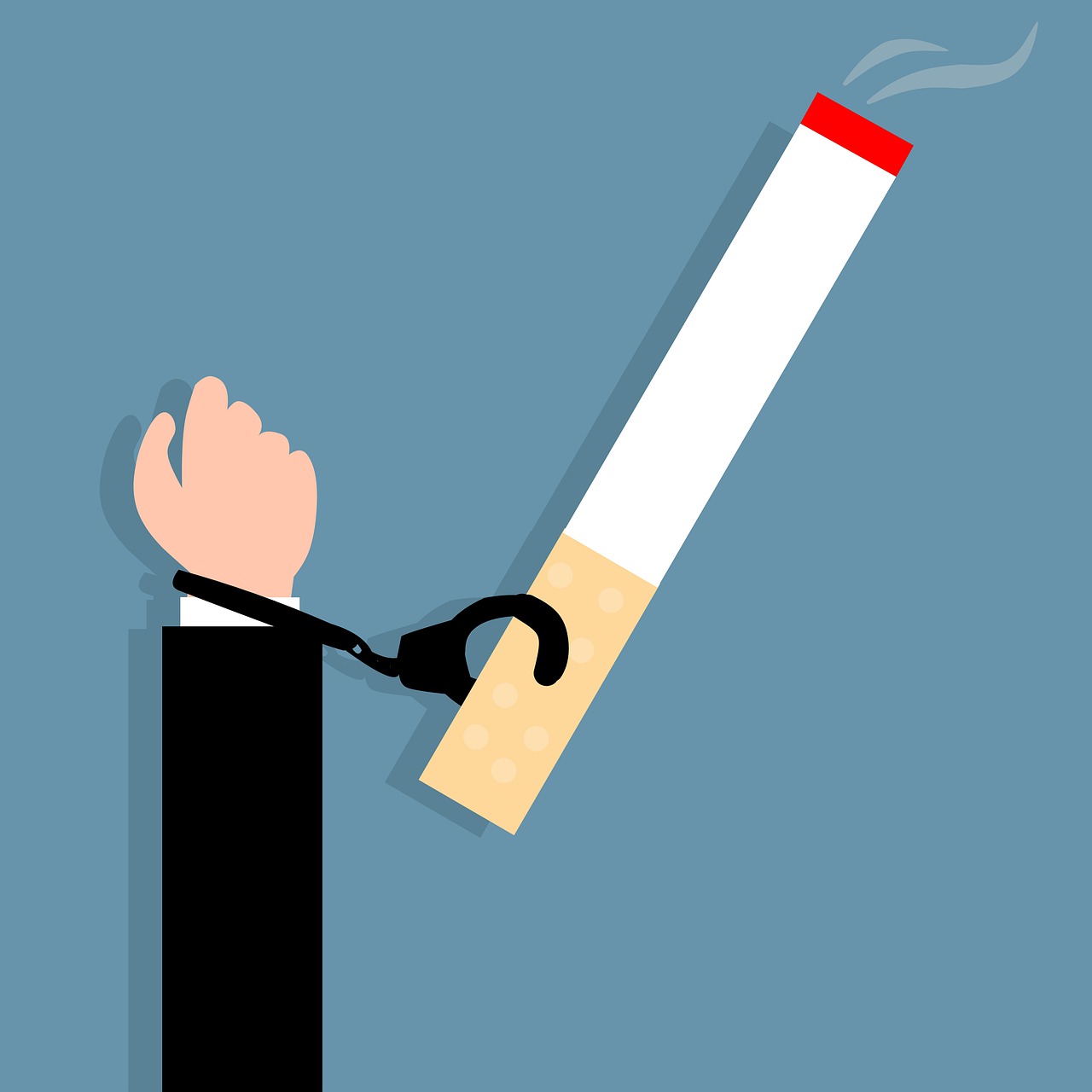
Another habit you may be tempted to fall back on is smoking. Cigarette smoking causes around 85 to 90 percent of all COPD cases and continuing to smoke with COPD will worsen the disease and trigger exacerbations. If you’re spending time with relatives that you used to smoke with or people who currency smoke this holiday season, this could cause you to slip back into an old habit. And even if you don’t smoke with this person, being around them will still expose you to secondhand smoke which can be just as bad.
Take Time Packing Your Medication
If you’re a COPD patient, your medication is paramount to your health. Whether you take orally administered medication, inhaled medication like nebulizer therapy or inhaler therapy, or some combination of the two, you’ll need to ensure that everything is packed and ready to go before you head out the door. If you haven’t done so already, be sure to renew your prescription for all of your medications so that you don’t have to worry about that when the time comes to leave.
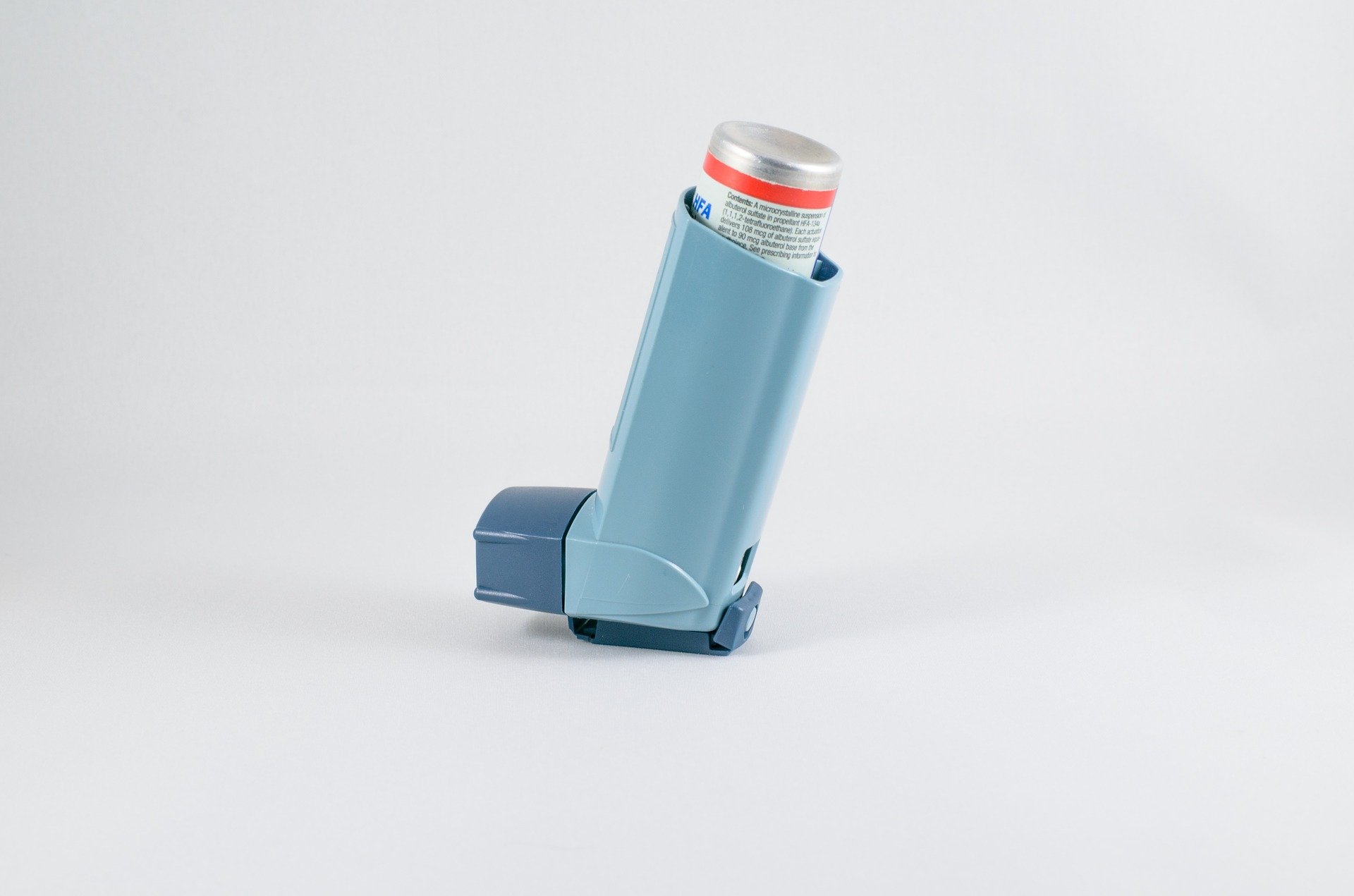
Long-acting bronchodilators are designed to relax the airways and help you breathe easier throughout the day. This includes drugs such as tiotropium, salmeterol, indacaterol, formoterol, arformoterol, and aclidinium. Short-acting bronchodilators, on the other hand, are designed to work quickly in the event that you experience a COPD exacerbation. Short-acting bronchodilators include albuterol, ipratropium, ipratropium bromide, and levalbuterol.
Plan a Pulmonary Rehabilitation Schedule
Pulmonary rehabilitation has been one of the most hotly debated aspects of COPD treatment plans. In the past, it was believed that any form of exercise would exacerbate respiratory systems. However, within the past several decades, studies have shown that a carefully planned and consistent exercise routine can improve lung strength and slow the progression of COPD.

While it’s tempting to forget about exercising and practicing breathing exercises while you’re away for the holidays, this will only put you behind on your treatment regime. Rather you should take the time to plan out your day and ensure that you follow all of your doctor's instructions. It may not seem like it, but even a small amount of moderate exercise can go a long way towards improving your long term prognosis and helping you feel better.
Check the Air Quality Index (AQI)
You may believe that, since the temperature is starting to drop, there’s no need to check the air quality index before you go outside. Unfortunately, this is simply not the case. Cold weather actually causes things like car exhaust and other types of air pollution to stick closer to the ground since the air is denser and moves more slowly. This means it’s more important than ever to check the air quality. What’s more, there are a number of wildfires still raging across the country which are filling the air with smoke.

According to this study, the most common types of pollution during winter months are PM10 (particulate matter that is 10 micrometers in diameter or smaller), sulfur dioxide, nitrogen dioxide, and carbon monoxide. Wildfires are a complex mixture of pollutants including fine particles, water vapor, carbon monoxide, carbon dioxide, nitrogen oxides, organic chemicals, and more. When you go to check the AQI in your area, be sure to keep an eye out for these.
.jpg)
COPD patients are considered part of the “sensitive group” when it comes to air quality. Generally speaking, COPD patients should not go outside if the AQI is over 100, but if you have late stage COPD, an AQI under 50 will be ideal. Like we discussed in our last blog post, there is an AQI mobile application that you can download on either your Android or iPhone that makes it simple and easy to check the air quality in your area.
Bring Clothing That’s Appropriate for the Weather
The weather has an immense impact on COPD symptoms. Extreme conditions, typically over 90 degrees Fahrenheit or below freezing can cause flare-ups and lead to unexpected side-effects like increased mucus production. Of course, the best way to cope with these weather conditions is to remain inside with the heater on, however, going outside may be unavoidable if you’re visiting relatives.
![]()
One of the best ways to keep your body temperature high while out in the cold is to wear multiple layers. Unfortunately, simply wearing a heavy jacket won’t do much to keep you warm and it could even restrict your breathing. Rather, you should wear several layers of flexible clothing that don’t add any unnecessary strain to your chest or stomach. Also, be sure to wear gloves, a hat, and a scarf.
For more information on managing COPD in cold weather, read our article titled, “The Complete Guide to Managing Your COPD in the Winter”.
Conclusion
It’s hard to believe that the holidays are just around the corner. In just a few weeks it will be time to pack the bags and head to the relatives’ house. And whether you’re planning on traveling across the country or next door, there’s a lot of planning COPD patients need to do in order to stay safe and healthy during this time. Follow the tips above to get you started and don’t hesitate to leave a comment below if you have any questions for us.
If you’re looking for a lightweight portable oxygen concentrator for your holiday trip, feel free to reach out to our respiratory specialists here at LPT Medical. We are happy to provide COPD patients with plenty of options from the most reputable brands in the industry like Caire Inc., Inogen, and Respironics. Some of our most popular units include the Caire FreeStyle Comfort, Inogen One G5, and the Respironics SimplyGo.
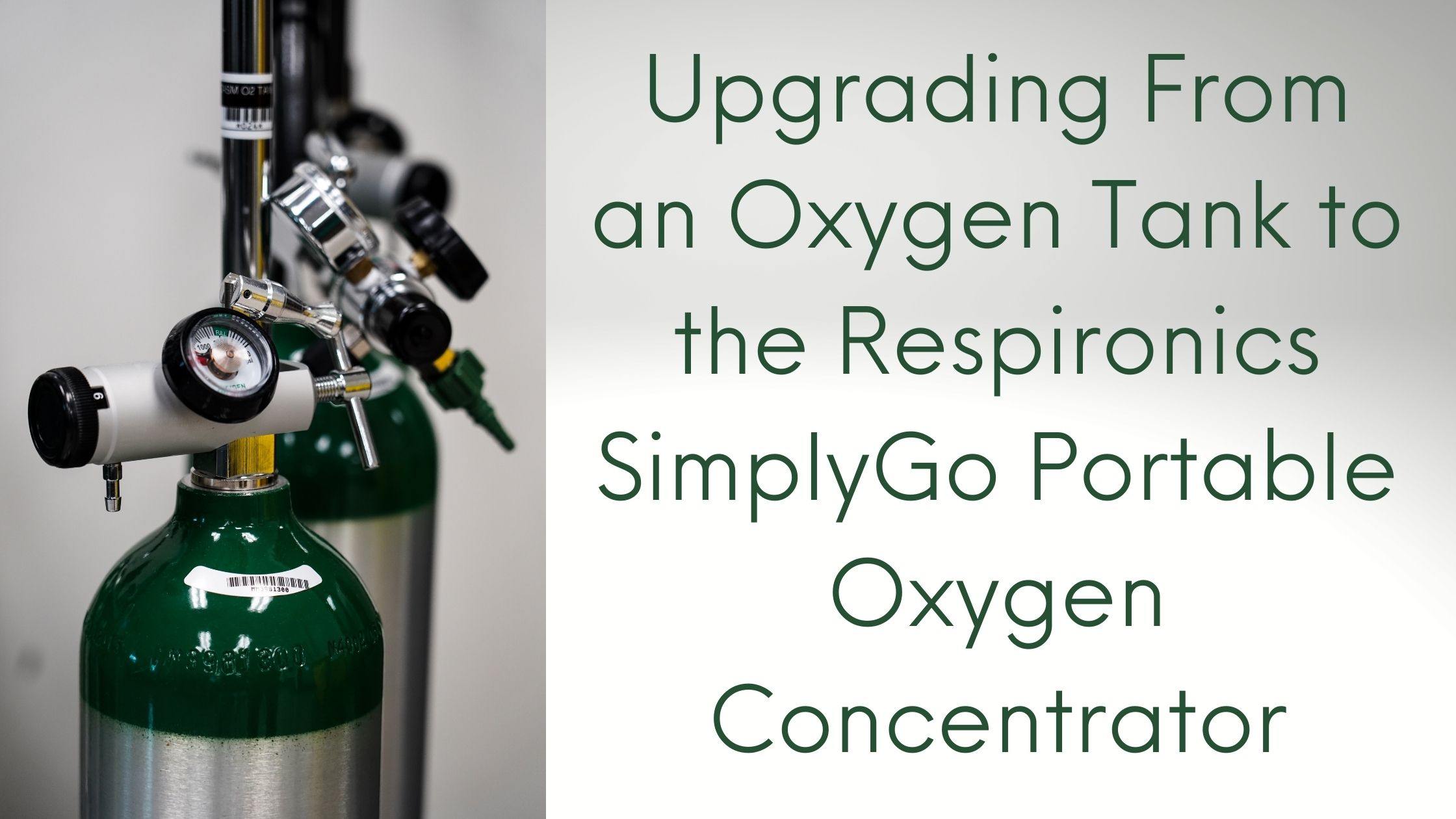
More than 1.5 million adults in the United States use supplemental oxygen to treat a variety of respective respiratory diseases. Oxygen therapy is used to improve the quality of life and prolong survival for patients with low oxygen levels. If you are a long time oxygen patient, or if you are someone who has recently been prescribed oxygen therapy, you might be curious what the transition from an oxygen tank to a portable oxygen concentrator would look like, and if the benefits of a POC would outweigh the costs associated with switching methods.
In this article we will talk about the logistics of switching to a POC from an oxygen tank so you can decide for yourself what the best option is.
{{cta('fa8abc2a-1e88-4fa3-82fd-1cb5b9ed43b2','justifycenter')}}
We will offer the Respironics SimplyGo as a reasonable device that will fit into most people’s oxygen requirements, however there are a plethora of other portable oxygen concentrators that might work better for you. For the sake of explaining the transition from a tank to a POC, we chose the SimplyGo as a great alternative oxygen device to an oxygen tank because it offers both continuous and pulse flow settings, and it is still very lightweight.
In this post we are going to cover:
- Health insurance
- Costs of a POC compared to the costs of oxygen tanks
- Specs of the Respironics SimplyGo
- Benefits of a owning a POC
Health Insurance

So, you've been diagnosed with a respiratory disease and your doctor tells you that you need supplemental oxygen in order to breathe better and stay healthy. After considering all of your options, you and your doctor decide that a portable oxygen concentrator is the best oxygen delivery method to fit your needs. The first thing you, and most people, want to know is whether it is covered by health insurance and medicare or not.
There is no simple answer, but, it is possible to get medicare and some insurance providers to cover part of the cost of a portable oxygen concentrator. But it's only in very rare cases, and it is unlikely for this to happen.
So why don’t insurance providers want to cover portable oxygen concentrators?
Medical insurance companies have a long reputation of finding any excuse to deny patients coverage for medical equipment and treatments. Even Medicare has a tendency to deny patients coverage for equipment that could make a huge difference in someone's health. They have strict rules that make getting coverage difficult and burdensome, and they often find reasons to deny approval for a treatment even when a doctor says that it's the best option.

It is more common for Medicare oxygen benefits to cover part of the rental for a portable oxygen concentrator, but even this is not easy. Medicare reimbursement simply doesn't pay suppliers enough every month for them to be able to afford to offer portable oxygen concentrators. Because of this, most people only have a few options for supplemental oxygen methods and have to choose between either liquid or gas tanks.
It's horrible that most medical insurance providers won't meet their patients' needs and help them get the medical equipment that's right for them and their lifestyle. That's why we've made it our mission to offer portable oxygen concentrators at the lowest possible price, so you can afford to get the oxygen delivery system that's best for you.
Cost of a Portable Oxygen Concentrator vs. Oxygen Tanks
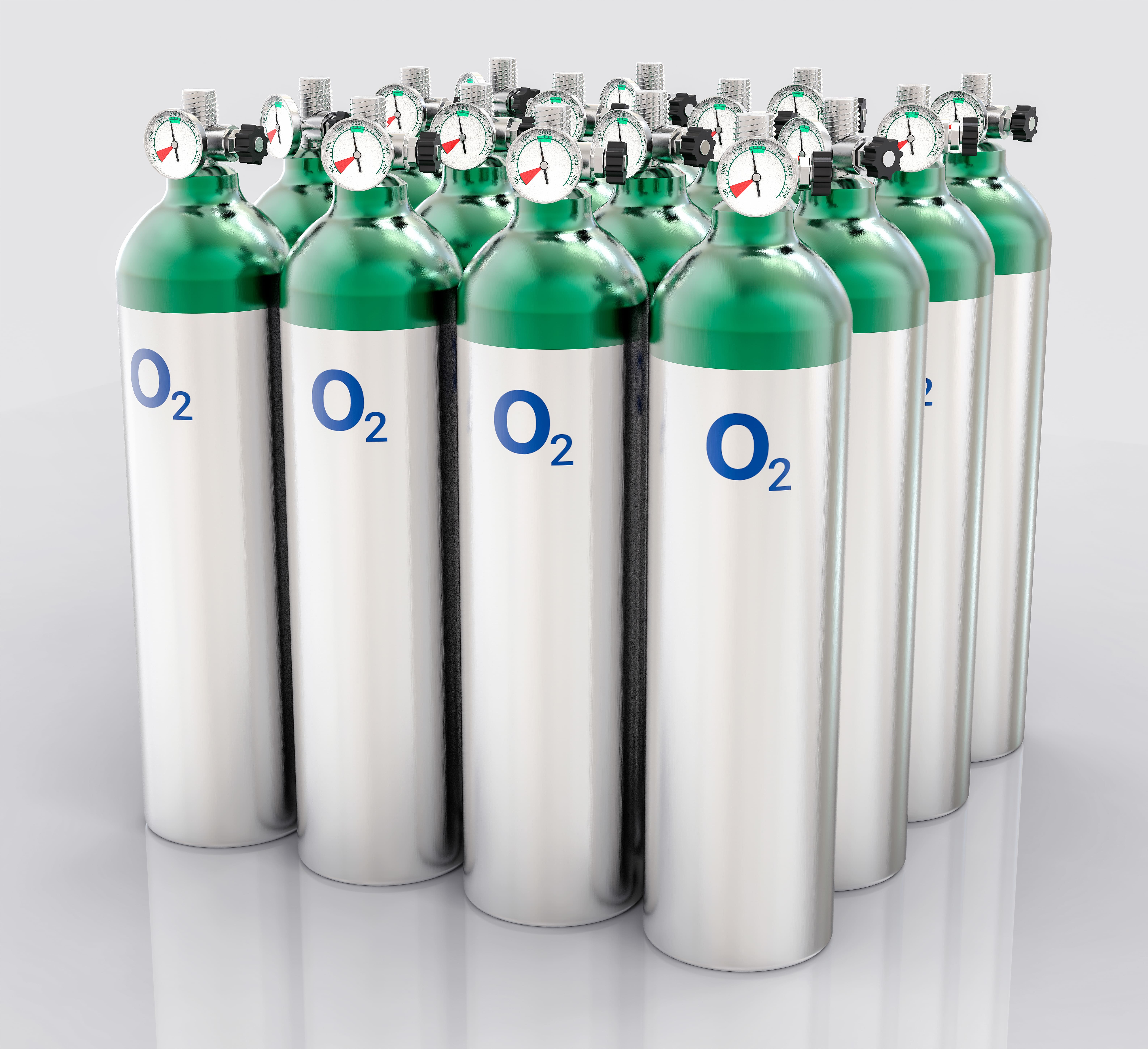
The price of oxygen equipment factors into most people's decision making process when it comes to deciding on an oxygen device. Unfortunately, maybe people are misinformed by their own research, and are paying too much for oxygen equipment that isn’t right for them.
One thing you must take into consideration when evaluating the prices of a POC compared to an oxygen tank, is that once a POC is paid for, there are no more expenses that you have to worry about. On the other hand, with oxygen tanks, you will continuously be paying for more oxygen every week for as long as you have the device. So, in the long-run, which device will actually be more expensive?
Oxygen tanks and oxygen concentrators ultimately serve the same main purpose for COPD patients: they provide supplemental oxygen to the patient in order to improve their oxygen levels to reduce shortness of breath, improve oxygenation and increase energy and well being.
{{cta('b59df0c1-c4de-47a8-8e1c-0d33d4b414aa','justifycenter')}}
Yet, oxygen concentrators and oxygen tanks offer very different daily experiences for the oxygen user, and this should be taken into account when you are weighing the costs associated with each device.
Tanks have significantly higher daily costs, but the cost for an oxygen tank upfront is very small. With the costs of refills and tank replacements, owning an oxygen tank comes out to more than $2,000 every year of owning one.
The cost of a portable oxygen concentrator varies depending on the device you get, if it is new or used, and whether you pay up front or finance the device from an oxygen equipment company. But no matter what the cost comes out to, your POC will last you several years, and you'll never pay for an oxygen delivery service nor wait around for a delivery again.

If you are hesitant about the prices of a reliable portable oxygen concentrator or spending too much money up front, please call 1-800-946-1201 so that one of LPT Medical’s respiratory specialists can help you find a portable oxygen concentrator that fits into your life for the best possible price.
Benefits of Owning a POC
In this section we are going to discuss the benefits of owning a POC as an oxygen patient and specifically what it is like to own the Respironics SimplyGo!

Weighing your Options... Literally
The weight alone is reason to switch from oxygen tanks to the Respironics SimplyGo. The SimplyGo weighs 10 pounds, and the shape is designed to be easy to carry and fit in small places.
Your SimplyGo package will include a custom carrying case and a wheeled travel cart so you have the option to carry it over your shoulder or you can pull it behind you on the travel cart.
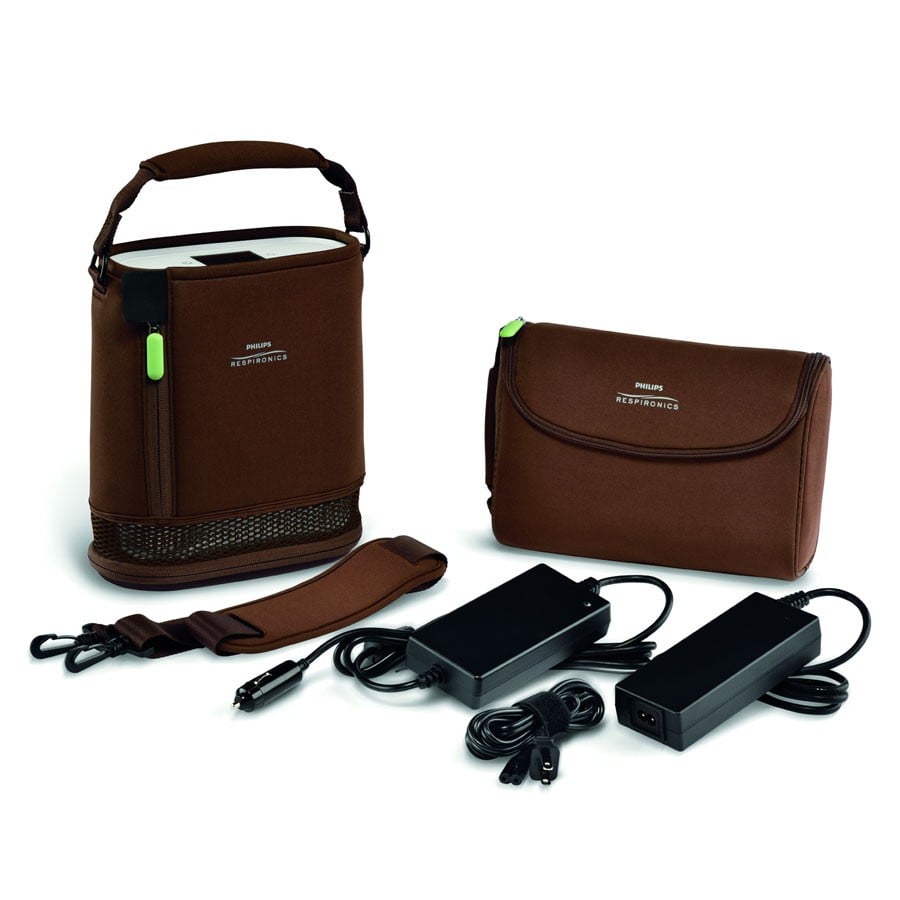
Travel with your Respironics SimplyGo
You can store it easily because of its sleek shape and most importantly you can bring it with you while you travel, either by plane, boat, RV, car, train, even by foot if you are so inclined. With an oxygen tank you are unable to use your oxygen on a plane, you can’t even bring it with you because of the oxygen hazard tanks create. Portable oxygen concentrators including the SimplyGo are all FAA approved for travel, and you are able to carry-on your device and not have to pay to rent one.

If you like to travel, you cannot fly with your own oxygen tank, therefore, you will be charged out of pocket for the rental of oxygen equipment while you are away, usually upwards of $300 per week. During your vacation or business trip, you will have to carve out time to pick up and return your oxygen equipment and plan on traveling to and from the oxygen rental service.
Powered by a Rechargeable Lithium-ion Battery
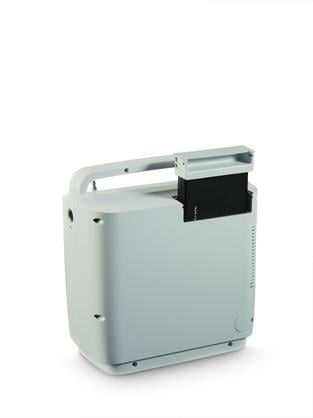
Having a battery powered oxygen device is a huge advantage for all oxygen patients. Rather than depending on a person to deliver and refill your oxygen tanks, you rely on yourself to charge the batteries every night.
You can recharge your device’ batteries simply by plugging it into the standard outlets in your wall as you would your cell phone. You are also able to charge the batteries in the car, RV, or even on a boat with the cigarette lighter and the DC cable your device will come with.
Having the accessibility to charge your device at any time, even while you are using it, gives you the freedom to be out of the house doing the things you love to do.
The Respironics SimplyGo gives you the ability to operate it using one or two batteries using the optional external battery module. One battery will be perfect for things like exercising, running quick errands, and doing things around your home while using two batteries is ideal for traveling, road trips, and extended trips away from your home.
Designed for 24/7 Use

Another main advantage to owning a Respironics SimplyGo is that you can utilize it day or night, even if you use a CPAP or BiPAP machine while you sleep.
The Respironics SimplyGo is CPAP/BiPAP compatible and it is equipped with both pulse flow and continuous flow oxygen delivery modes, as well as pulse flow settings 1-6 and continuous flow settings 0.5-2.0 LPM, so you will be covered you when you exercise, sleep, rest, and do a regular daily chorus.
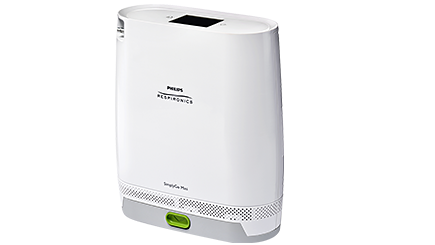
One additional feature the SimplyGo has to offer is its sleep mode technology. Whether you’re on the airplane or relaxing in your chair at home, and you feel yourself dozing off, you can turn sleep mode technology on to ensure your oxygen gets delivered while you are sleeping.
The sleep mode technology enhances the device’s sensitivity to detect your breath and it softens the pulse flow delivery so it doesn’t wake you up. Don’t worry, if your SimplyGo doesn’t detect a breath or if you breathe through your mouth it will automatically switch back over to continuous flow to ensure you get your required oxygen.
Independence

We find that many oxygen patients are still frequently active, love to travel, and work in their respective capacity. You might have a story similar to some we have heard where your oxygen equipment holds you back from certain events or goals.
Many oxygen tank users encounter issues with delivery delays, or lack of inventory. There have been many instances where someone has been tested on a continuous-flow, liquid oxygen system, but their supplier could only provide them with pulse-dose compressed air tanks and a heavy floor concentrator thereby tethering them to their home, constraining them from their obligations and priorities.
So even though they should have a portable tank, they are left at the will of what their oxygen supply company provides them, which is no where near the freedom and independence they deserve.
Also if you decide to stick with an oxygen tank, you cannot make any other plans on delivery days since there is no way to know what time they will come.
With the help of a reliable and portable oxygen device, and provided with sufficient oxygen, oxygen users are healthier and can continue to contribute to their families and to society. It is no secret that most people who require supplemental oxygen also enjoy activities, work, and freedom over sitting at home tethered to an oxygen hose.

Overview
The transition from a oxygen tank to a portable oxygen concentrator is a clear step in a direction that will give you more freedom and independence, the ability to travel, and the motivation you need to make the most out of daily activities without being weighed down and tethered to an oxygen hose inside your home.
While this may not be an option for everyone, depending on your oxygen requirements, the Respironics SImplyGo can cover most oxygen users needs. It is a great device should you need to transition between continuous flow and pulse flow, but it is still lightweight so if you enjoy long walks, running errands, exercising, or just being able to maneuver around your house, this device will help you along the way rather than get in your way.
%20(1).png)
If you have chronic obstructive pulmonary disease (COPD), cystic fibrosis, or any other debilitating lung condition, you likely depend on a strict treatment regime that encompasses all facets of your life. Typical treatment plans usually involve an improved diet high in protein and fiber, an exercise routine that improves lung strength and endurance, and most importantly oxygen therapy which helps stabilize your lung condition and ensure blood oxygen levels are normal.
One concern many people have with these lifestyle changes is that they make you increasingly dependent on medical devices like your oxygen concentrator, nebulizer, or inhaler. If these devices stop working suddenly, you may be stuck in a situation where you’re unable to get the medication you need. This issue only gets worse as your disease progresses because your doctor may require you to use oxygen for longer periods of time each day.
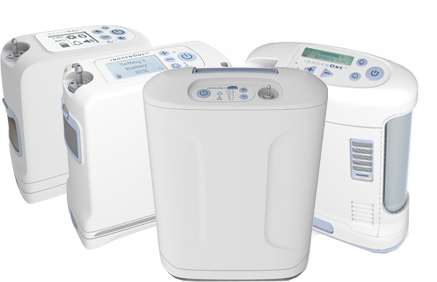
Fortunately, we live in a time of innovation and the medical devices we have access to today are far more reliable than in the past. Portable oxygen concentrators, for example, are battery-operated oxygen machines that are praised for their reliability and long lifespan. Rather than going out of your house each day worrying that you may lose access to your oxygen supply, portable oxygen concentrators allow you to focus on things that are important to you in your day-to-day life.
If security is important to you, stick around because we’re going to take a look at the most reliable portable oxygen concentrators in 2021. Whether you’re a first-time buyer or you’ve owned a POC in the past, you’re sure to find something on this list that suits your lifestyle. If you have any questions, be sure to leave them in the comment section below or reach out to us to speak with a respiratory specialist.
{{cta('fa8abc2a-1e88-4fa3-82fd-1cb5b9ed43b2','justifycenter')}}
Why Choose a Portable Oxygen Concentrator?
You may be thinking to yourself, “what’s so special about portable oxygen concentrators?” After all, there are plenty of other options available like oxygen tanks, liquid oxygen tanks, and stationary oxygen concentrators. And while these oxygen devices have served their purpose for many decades, they simply can’t compete with the state-of-the-art design of modern portable oxygen machines.
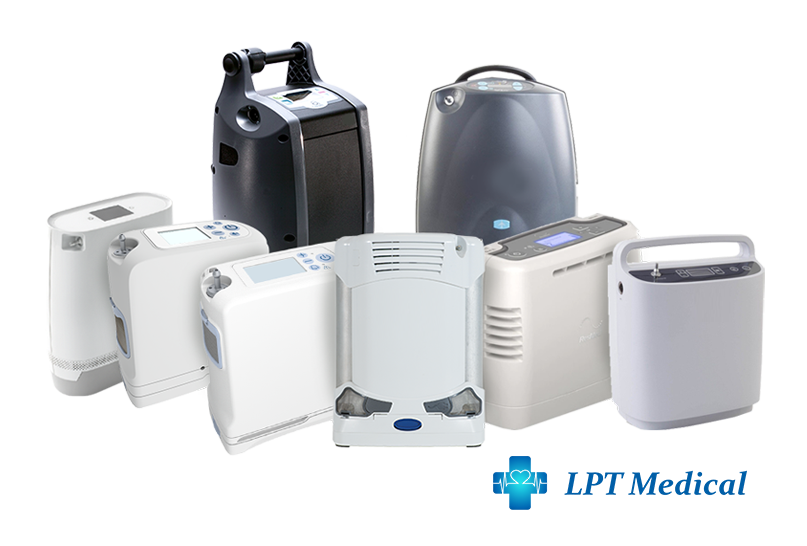
The truth is that oxygen tanks and stationary concentrators have overstayed their welcome in many ways. Oxygen manufacturers have shifted their focus to battery-powered portable oxygen delivery systems because they provide their customers with more freedom and convenience in their daily lives. Rather than being confined to your home with a heavy and bulky oxygen tank, POCs allow you the freedom to live life on your own terms.
At this point in time, portable oxygen concentrators are the only oxygen delivery devices that are approved by the Federal Aviation Administration (FAA) for in-flight use due to safety concerns. What this means is that if you choose to use an oxygen tank or liquid oxygen tank, you’re largely forfeiting your ability to travel long-distance. On top of this, other modes of transportation like driving, walking, or taking the bus will be much more difficult and stressful.
.jpg)
The Caire FreeStyle Comfort
If reliability is important to you, there is no better portable oxygen concentrator out there than the Caire FreeStyle Comfort. In fact, this is one of the only concentrators currently in use by military personnel meaning it’s a trusted product even under the most strenuous of circumstances. The Caire FreeStyle Comfort also sees use in a variety of other industries including space exploration laboratories, hospitals, and in-home use.
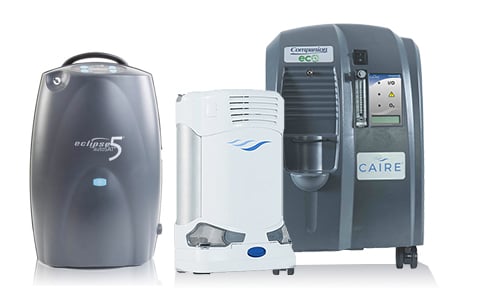
While Caire Inc. may not be a household name in the oxygen industry, you may recognize their products under the name AirSep, Helios, and SeQual. The Companion 5, for example, is one of their top stationary oxygen concentrator designs offering economic in-home oxygen delivery and easy-to-use controls. They’ve also produced continuous flow portable oxygen concentrators like the SeQual Eclipse 5 which offers up to 3 liters per minute (LPM) of oxygen and 9 pulse flow settings.
One of the most unique things about the Caire FreeStyle Comfort is its mobile application, CAIREView Telehealth Technology. This app can be downloaded on any phone, tablet, or computer and connect to your Caire FreeStyle Comfort via Bluetooth. It has two primary benefits. First and foremost, it enables you to track all your oxygen usage through a simple-to-use dashboard. It will provide you with information such as hours of use, flow settings used, and alerts.
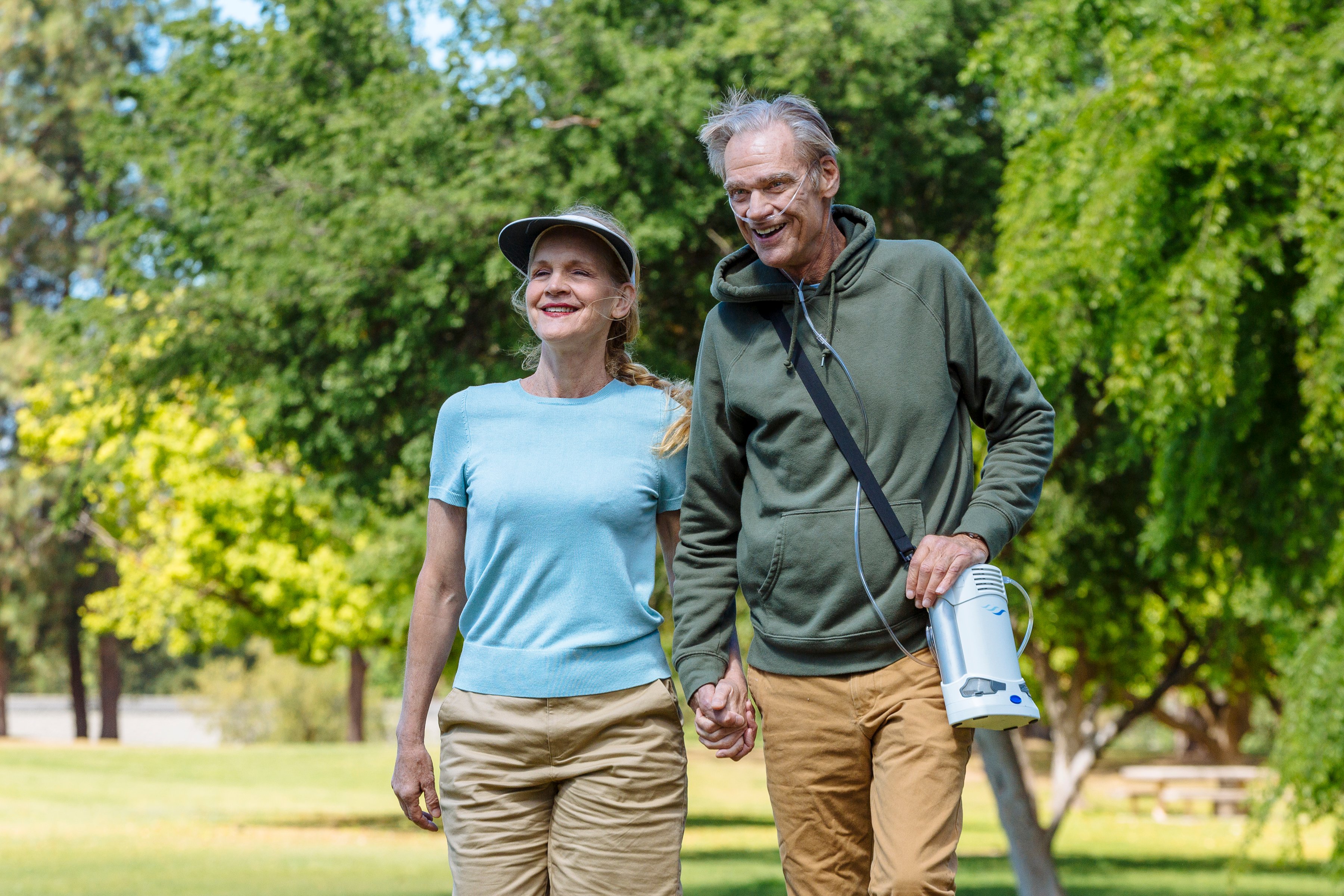
Secondly, this application allows for periodic monitoring to ensure that patients comply with their oxygen treatment plan. Clinicians will be able to view up-to-date data about your oxygen usage and assist remotely by monitoring your device settings. This feature significantly increases the reliability of your device, because in the rare chance that it stops working or you stop receiving the oxygen you need, your doctor will know about it immediately and he/she will notify you.
Caire FreeStyle Comfort Specs
|
Weight
|
5 pounds
|
|
Flow Rate
|
Pulse 1-5
|
|
Warranty
|
3-year
|
|
Height
|
10 inches
|
|
Width
|
7.3 inches
|
|
Depth
|
3.1 inches
|
|
FAA Approved?
|
Yes
|
|
Battery Duration
|
Up to 16 hours
|
{{cta('43b79c5e-6bd6-4f02-ac27-2d038d20c146','justifycenter')}}
The Inogen One G5
Inogen is one of the top pulse dose portable oxygen concentrator manufacturers in the industry. While Inogen has only been around since 2001, they made a name for themselves very quickly. While they started off with stationary oxygen concentrators, they made their way into portable oxygen concentrators with the Inogen One G1. There are currently five generations of Inogen POCs, and their latest, the Inogen One G5, is one of the most advanced on the market.
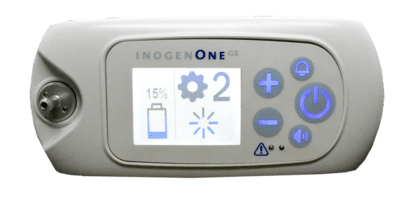
On most fronts, the G5 is pretty neck-in-neck with the Caire FreeStyle Comfort. They both offer 6 pulse flow settings, they’re both around 5 pounds, and they’re about the same size. However, the Inogen One G5 has a great reputation for having an extremely low failure rate and a long lifespan between 5 and 7 years.
Similar to the Caire FreeStyle Comfort, the G5 is accompanied by a mobile application called Inogen Connect. This app was introduced with the Inogen One G4 and allows you to manage your flow rate and device settings remotely. This is great if you carry your POC on your back and don’t want to take it out all the time to adjust your oxygen settings.
Inogen One G5 Specs
| Weight |
4.7 Pounds |
| Dimensions |
8.15" H x 7.19" L x 3.26" W |
| Flow Settings |
Pulse Settings 1-6 |
| Sound Level |
37 dBA @ Setting 2 |
| Expected Battery Life |
Up to 13 Hours |
.png)
{{cta('fa8abc2a-1e88-4fa3-82fd-1cb5b9ed43b2','justifycenter')}}
The Inogen One G3
Although the Inogen One G3 released all the way back in 2012, that hasn’t set it back when it comes to being a dependable portable oxygen concentrator. While the G3 certainly has a little less oxygen output than the Inogen One G5 or the Caire FreeStyle Comfort, it makes up for it with an array of useful accessories that help you customize your oxygen therapy.

One of the most unique accessories for the Inogen One G3 is the GO2 Carryall. This product is designed to look like any ordinary purse or handbag but it holds your G3 snuggly and securely inside. It also comes with both a hand strap and a shoulder strap so you can choose exactly how you want to carry your portable oxygen concentrator.
One thing you’ll notice right away about the GO2 Carryalls is that they’re way more fashionable than any other POC carrying case you’ve seen in the past. They come in either black or brown to match your wardrobe and they’re made of genuine leather so that no one would ever suspect there’s a portable oxygen machine inside. There’s also plenty of room for personal belongings like your car keys, a wallet, or your G3 user manual.

While fashion is important for many people, the most important thing about the GO2 Carryalls is that they protect your Inogen One G3. When your G3 is inside one of these bags, you can rest assured that it will be protected from things like scratches, dents, and even minor water damage. Although the GO2 Carryalls are water-resistant, they are not fully waterproof, so you’ll want to find some cover if you’re getting rained on.
All-in-all, the GO2 Carryalls make the G3 one of the most reliable oxygen concentrators on the market. These bags have a mesh material on the side where the intake vents are located so that your device never overheats or stops working. It also enables you to carry your Inogen One G3 conveniently at your side so that you can keep track of it. However, if the GO2 Carryalls don’t appeal to you, you’ll be happy to know that there are three other carrying options: the G3 custom carrying case, the G3 backpack, and the G3 rolling backpack.
Inogen One G3 Specs
|
Weight |
8-Cell: 4.8 Pounds; 16-Cell: 5.8 Pounds |
|
Dimensions |
7.25” Wide x 3” Deep x 8.75” High |
|
Flow Rate |
Pulse Flow Settings 1-5 |
|
Battery Life |
8-Cell: Up to 4 Hours; 16-Cell: Up to 8.5 Hours |
|
Power |
100-240 VAC, 50/60 Hz; 11-16 VDC |
|
FAA Approved |
Yes |
|
Warranty |
3 Years |
The Respironics SimplyGo
All of the aforementioned machines have been pulse dose portable oxygen concentrators. What this means is that they closely monitor your breathing rate and deliver oxygen only at the peak of your inhalation. The Respironics SimplyGo differs from these in the fact that it also has a continuous flow setting. In other words, it can deliver oxygen indiscriminate from your breathing rate. The Respironics SimplyGo can deliver up to 2 LPM of continuous flow oxygen.

One of the most important things to note about the Respironics SimplyGo is that it is the lightest continuous flow portable oxygen concentrator on the market. Whereas most continuous flow units need to be wheeled around on a carrying cart, the SimplyGo is light enough to carry on your shoulder or your back. This may not seem like a big deal, but for someone who’s been prescribed continuous oxygen, it can be a life-changer.
If you’ve been an oxygen patient for some time, you know that having to wheel around your oxygen concentrator can be a huge pain. Not only do you have to make sure that it’s not bumping into anyone but there’s always a chance of your oxygen tubing getting caught on something and damaging your unit. Walking in a busy area is difficult and it can distract you from what you’re trying to do.
Using the convenient carrying case, you can ensure that you always have a reliable source of oxygen wherever you go. The Respironics SImplyGo was designed for people with the highest oxygen demands so it can run 24/7 without running into any problems. Since it’s a continuous flow POC, it’s perfectly compatible with CPAP, BiPAP, or APAP machines. In other words, it’s one of the most reliable portable oxygen concentrators for people who have both COPD and sleep apnea.
Respironics SimplyGo Specs
|
Weight |
10 Pounds |
|
Dimensions |
10” H x 11.5” W x 6” D |
|
Flow Rate |
Continuous Flow 0.5-2.0 LPM Pulse Flow Settings 1-5 |
|
Battery Life |
Continuous Flow Up To 0.9 Hours Pulse Flow Up To 3.0 Hours |
|
Power |
100-240 VAC, 50/60 Hz; 19 VDC |
|
FAA Approved |
Yes |
|
Warranty |
3 Years |
Tips for Extending the Life of Your Portable Oxygen Concentrator
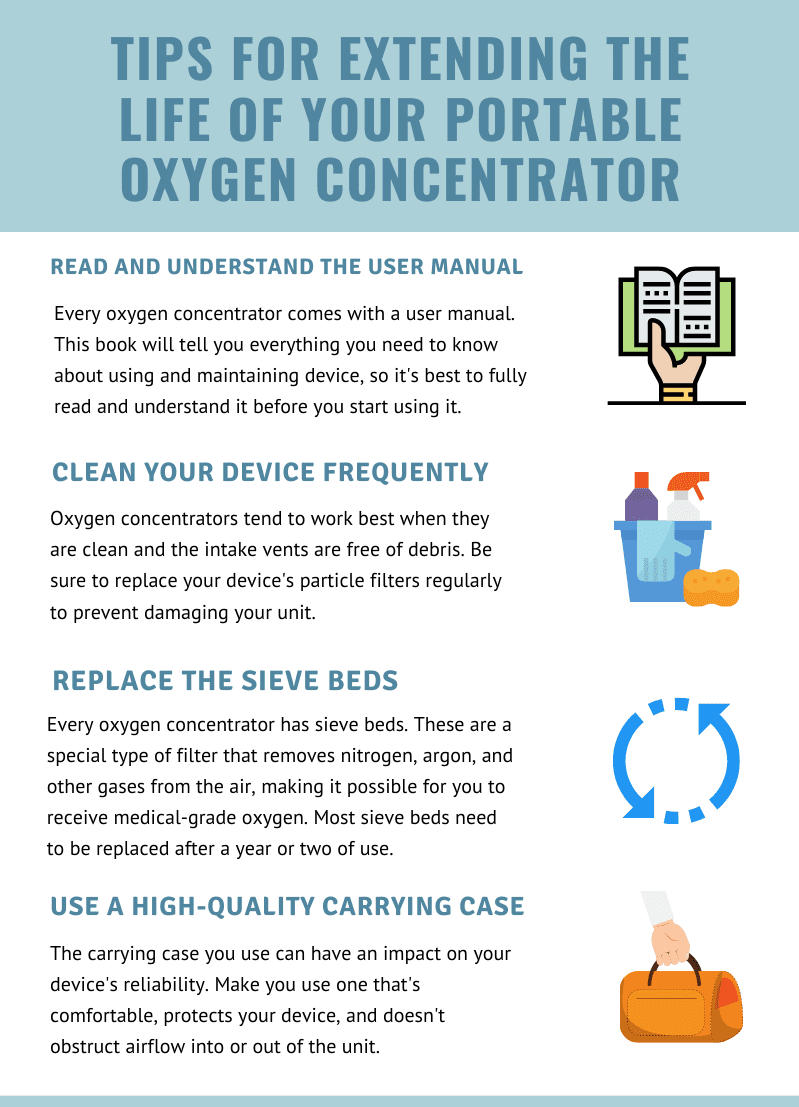
Conclusion
Dependability is one of the most important attributes of portable oxygen concentrators. If you’re looking for a POC, it means you want to be able to get out of the house and enjoy your freedom, so your device needs to be able to match your lifestyle. While there are plenty of great oxygen concentrators out there, the ones above will offer you the reliability you need to live life on your own terms.
If you’re still struggling to find the right portable oxygen concentrator for you, don’t hesitate to reach out to our respiratory specialists here at LPT Medical. We’ll walk you through all your options ensuring that both your oxygen needs are met and you have a unit that will give you the freedom you need to go about your daily life.


 So we can find the best portable oxygen concentrator for your needs!
So we can find the best portable oxygen concentrator for your needs!

